Search Results for: Nils Stolpe
Nils Stolpe: It’s not the fault of the wind industry??? Sophistry is the use of fallacious arguments, especially with the intention of deceiving.
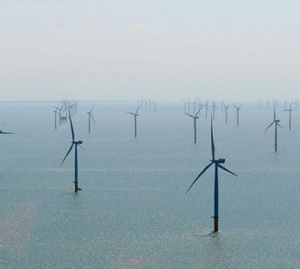 The “We’re for ocean wind power, the Hell with the rest of the oceans” claque have been yammering their “it’s not the fault of the wind industry” chant ever since an unprecedented number of dead or dying whales and dolphins started washing up on New York and New Jersey beaches. Since December of this past year, when each of these incidents (was?) turned into a media event, it has been inevitably accompanied by some government (from Washington or Trenton) official, some (oddly enough, almost assuredly Democratic) legislator, some presumed objective scientist (doing an on-camera or recorded interview) with his or her hand held out for her or his share of what are very likely going to be billions of state, federal or wind industry research dollars, or some so-called environmentalist with the same goal. Just about all of them are insistently proclaiming “there is no proof that sonar testing (or any other testing being done by/for the wind industry) kills whales and/or dolphins.”
The “We’re for ocean wind power, the Hell with the rest of the oceans” claque have been yammering their “it’s not the fault of the wind industry” chant ever since an unprecedented number of dead or dying whales and dolphins started washing up on New York and New Jersey beaches. Since December of this past year, when each of these incidents (was?) turned into a media event, it has been inevitably accompanied by some government (from Washington or Trenton) official, some (oddly enough, almost assuredly Democratic) legislator, some presumed objective scientist (doing an on-camera or recorded interview) with his or her hand held out for her or his share of what are very likely going to be billions of state, federal or wind industry research dollars, or some so-called environmentalist with the same goal. Just about all of them are insistently proclaiming “there is no proof that sonar testing (or any other testing being done by/for the wind industry) kills whales and/or dolphins.”
This is sophistry, and it is sophistry being fueled by a false equivalency-that no proof that the testing in question harms/kills whales/dolphins is equivalent to there being proof that the testing in question does not injure/kill whales/dolphins. This is reducing sophistry to its most elementary, its most transparent, and its most pathetic level. Whenever an employee of the National Oceanographic and Atmospheric Administration (NOAA), the Bureau of Ocean Energy Management (BOEM), the New Jersey Department of Environmental Protection (NJDEP), the New Jersey Board of Public Utilities (NJBPU), President Joe Biden, NJ Governor Phil Murphy, or any of the organizations or corporations looking forward to turning our oceans into the seaborne equivalent of industrialized northern New Jersey, wants you to believe that “there is proof that sonar testing (or any other testing carried out in the campaign to industrialize our mostly pristine ocean) doesn’t kill whales and/or dolphins.” There isn’t any such proof, and if they had the strength of any convictions at all, they would be up front about it. But unfortunately, when it comes to elected officials, the convictions they seem to be focused on involve questionable campaign contributions or financial transactions, not accuracy in their pronouncements.
Had any of the functionaries who have been so intent on befuddling the public on this issue ever been exposed to an Introduction to Philosophy course (and gotten anything out of it other than a grade), perhaps they would realize this. But then again, perhaps not. Perhaps they also realize this themselves but think (or hope) you won’t. Or perhaps they realize that their future promotions and eventual retirement depend on not embarrassing the President or the Governor by contradicting either one. I was there in a prior existence, and I can definitely vouch for that one.
This is such a fundamental fact in dealing with the dead or dying whales and dolphins that I’m compelled to repeat it: There is no proof that sonar testing or related activities doesn’t kill whales or dolphins.
Without a major public outcry, what’s going to be a burgeoning wind-power industry’s virtually instantaneous creation-without the level of objective environmental, social and economic oversight that such a huge undertaking demands (or should demand)-might well cost us far more than most of us are willing to pay. And we’re not going to know until it’s too late.
The only logical response to the pro wind forces’ contention that “there’s no proof that prep work for offshore wind power is responsible for whales or dolphins dying.” has to be so what? Do the research, identify the potential problems, and then if the costs are worth it, get started. But don’t allow the wind development people to use the “public panic” that has been building for most of a decade to ignore federal, state, and local legislative and regulatory requirements that have evolved for most of a century in their race for the gold ring that taxpayers and ratepayers are going to be paying for.
Lauren Gaches, a spokesperson for the National Oceanic and Atmospheric Administration, said there is no evidence “to support speculation” that noise resulting from offshore wind site work is killing whales, adding the agency will continue to study the matter.
To get an idea of what coastal residents, recreational and commercial fishermen, boaters, commercial vessel operators, folks who like the oceans just the way they are, and all of those whales and dolphins are up against, do a web search on “whales evidence wind energy -orcas.” (the “-orcas” is to avoid the recent spate of media attention focused on a handful of orcas which have assaulted a smaller handful of sailing vessels in the Mediterranean). Many of the millions of hits will involve a relatively small number of purported facts, most of them echoing what NOAA laid out in the above quote. Coincidental? Not hardly! All resulting from a whole bunch of reporters doing an awful lot of independent research (yea, right! That’ll be the day!), or an awful lot of hand-holding and very purposeful “misdirection” by a bunch of bureaucrats who, considering the degree of public commitment by the President of the United States and the Governor of New Jersey, aren’t going to do, say or write (or probably even think) anything which isn’t toeing the federal line, ‘cause that isn’t going to get anyone ahead in either the federal or the state bureaucracy. Or get you on the imminent grant gravy train from the feds or from the prospective wind energy mega-moguls.
Some individuals and some organizations-more’s the pity-are trying to preserve their own little slice of the ocean pie regardless of any potential threats to the ocean environment and the critters-not just the whales and dolphins-in it. A far smaller number aren’t and are actively but individually campaigning against it.
Considering the knots that the anti-fishing environmental organizations have tied the domestic commercial fishing industry into (with the apparent tacit approval of NMFS/NOAA in many cases) over the last three or so decades, a bunch of individual uncoordinated efforts are probably not going to work out all that well. Reaching out to other groups and individuals who are as equally against turning our oceans into the oceanic equivalent of New Jersey’s Bayway Refinery in NJ might be a more effective option. But whatever you do, don’t sit on your hands, doing nothing while watching it all happen. Our oceans, our whales and dolphins, our inshore and offshore ecosystems and all of the critters they support are much too valuable -maybe even to the pols and the big wind developers-and the last thing that we should do is willingly let it happen. So get involved, get organized and remember that there’s no good reason to turn the Jersey Shore into an extension of the wall-to-wall industrial development in North Jersey. More environmentally acceptable sources of electricity are available today, and more are on the way.
One more question –
Much has been made about the relationship between increased international shipping in the Port of NY and NJ, ocean warming/climate change, vessel strikes and fishing gear interactions and abnormal (in spite of what NOAA/NMFS says) whale/dolphin mortalities. Not much has been made, however, of the fact that over the last several months the whale/dolphin mortalities appear to have dropped to somewhere around their “normal” level. Commercial fishing landings (and by projection commercial fishing pressure and commercial fishing activities) haven’t changed significantly. Reports are that commercial shipping traffic has not varied since the beginning of the covid crisis, and the weather/climate hasn’t changed noticeably. If BOEM and NOAA/NMFS are anywhere near accurate in their guesses about the causes of the abnormal number of cetacean deaths, why has the number of dead whales and dolphins dropped precipitously in the last two months? About the only remaining factors that could be a significant cause of mortality are seismic testing and/or related big wind activities. Would it surprise anyone to learn that the testing boats with their lucrative contracts with Big Wind, or some enterprising public officials, or some unscrupulous politician, or some on-board “experts,” might exert adequate pressure to insure that whale/dolphin mortality due to seismic testing be put on hold, via putting the testing itself on hold, until the media heat, which was reaching a crescendo just before the whales and dolphins apparently gained their new lease on life, moved on to the next cause célèbre? Or could the testing sites temporarily shift to areas that the whales and dolphins avoid, or did the on-board observers finally figure out how to do their jobs.
I’m not saying any of these factors are to blame, but until we know what is responsible, we’re not going to know how or if it can be controlled. To continue full-bore ahead with the wind power development off our coast without knowing that is at best irresponsibility, at worst it’s negligence (and perhaps illegal).
______________________________
And finally, we have some possible light at the end of the “1,000 feet tall (measured from the sea surface) threats to our oceans ecosystem” saga from the intro to OFFSHORE WINDMILLS WILL COST CAPE MAY, NJ, $1B IN TOURISM REVENUE from the NJ101.5 website at https://tinyurl.com/3rub8ctm:
– Eric Scott
May 26, 2023
Cape May County Commissioners have unanimously passed a resolution opposed to offshore wind projects and vow to continue to fight the installation of wind mills off the coast.
A report supporting the resolution claims the windmills will cost Cape May County more than $1.1 billion in lost tourism revenue and will have a devastating impact on food service, hospitality, retail, rental housing and other segments of the local economy.
Wind developer Orsted, the report claims, has admitted 15% of tourists will not return to Cape May once its windmill project is completed and that it’s turbines will be visible from every beach in Cape May County.
Cape May County Board of Commissioners Director Len Desiderio said in a statement that the county had been trying to work with Orsted to try and mitigate the negative impacts of the Ocean Wind One offshore wind generation facilities project, but “as time went by, it became clear that Orsted was not interested in finding any compromise.”
“It is clear to us now that the approach among this foreign corporation and their partners in the state and federal governments is to build these things as fast as they can despite the potential for devastating environmental and economic impacts, ” Desiderio said.
Cape May County has hired a Virginia environmental law firm and former New Jersey Superior Court Judge Michael J. Donohue as Special Counsel in preparation for legal action against Orsted and state and local government agencies.
Go to https://tinyurl.com/3rub8ctm for the full text.
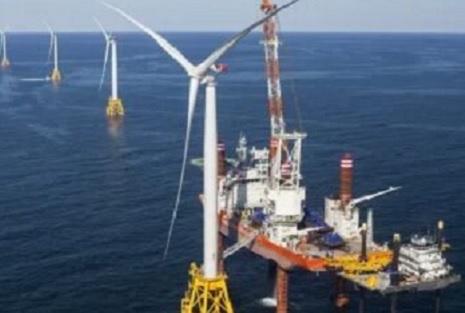
Where have all the dead whales gone? By Nils Stolpe, FishNet-USA
Beginning in December of last year and extending through most of the first quarter of 2023, New Jersey and New York beaches were inundated with abnormally high numbers of dead or dying whales and smaller marine mammals. These majestic creatures-though not so majestic when being pushed about willy-nilly by tides, wind, waves and various types of earth moving machines-have never expired in such large numbers in such publicly accessible locations in local residents’ memories. Perhaps coincidently, intensive hydroacoustic surveys to determine the suitability of potential sites for the construction of thousands of gigantic windmills and their supporting infrastructure (supposedly to help us all survive what is being sold as an imminent energy/climate crisis) were being committed offshore of the beaches where all of these marine mammal deaths and strandings have been concentrated. To us inveterate observers of that hunk of Atlantic Ocean real estate known as the New York Bight, and the critters that temporarily or permanently live there, and of the actions of the public agencies charged with-and entitled to tens of millions of taxpayer dollars each year to do so-administering the Endangered Species and the Marine Mammal Protection Acts, that surely hints at, at best, ineptitude at that’s ineptitude at a fairly advanced level. >click to read the article< 16:14
Where have all the dead whales gone? By Nils Stolpe, FishNet-USA
 Charismatic Megafauna… “are animal species that are large—in the relevant category that they represent—with symbolic value or widespread popular appeal, and are often used by environmental activists to gain public support for environmentalist goals.” (Wikipedia) Whales are among the quintessential charismatic megafauna groups, having been hunted almost to extinction and only gaining international protection in the mid-twentieth century. Since then many species have flourished though a few are still threatened with extinction. Hence the massive amount of media attention generated by a single individual death, particularly when the dead or dying whale is accessible to tourists.
Charismatic Megafauna… “are animal species that are large—in the relevant category that they represent—with symbolic value or widespread popular appeal, and are often used by environmental activists to gain public support for environmentalist goals.” (Wikipedia) Whales are among the quintessential charismatic megafauna groups, having been hunted almost to extinction and only gaining international protection in the mid-twentieth century. Since then many species have flourished though a few are still threatened with extinction. Hence the massive amount of media attention generated by a single individual death, particularly when the dead or dying whale is accessible to tourists.
“Latest figures show that over 13 million people a year are taking a whale watch trip, in an industry spanning 120 countries and overseas territories worldwide, generating $2.1 billion in total revenues.” (Ulla Christina Ludewig and Vanessa Williams-Grey, Responsible Whale Watching, Whale and Dolphin Conservation, 2019 tinyurl.com/328zhcc9
——————-
Humpback Whale Unusual Mortality Event (UME) Along the Atlantic Coast
Since January 2016, elevated humpback whale mortalities have occurred along the Atlantic coast from Maine through Florida. A portion of the whales have shown evidence of pre-mortem vessel strike; however, this finding is not consistent across all whales examined. More research is needed. (from NJDEP 2016–2023 Humpback Whale Unusual Mortality Event, https://dep.nj.gov/humpback-whale-unusual-mortality-event/federal-resources/)
——————-
“Republicans have claimed that the deaths are linked to offshore wind development. Amendments in the House energy bill would have required the Government Accountability Office to study the potential impacts of offshore wind on tourism, military activities, and marine wildlife. “Like the canary in the coal mine, the recent spate of tragic whale deaths shed new light and increased scrutiny to the fast-tracking of thousands of wind turbines off our coast,” said Representative Chris Smith, a Republican from New Jersey, at a hearing in March.
Instead, the agency states that “the greatest human threats to large whales” are vessel strikes and entanglement in fishing gear. Examinations of about half the humpback whales stranded since 2016 attributed 40 percent of the deaths to either of the two causes. (The other half of the beached whales were too decomposed to analyze.)
A few bigger trends could be behind the increase in whale mortality. One is climate change — warming waters have pulled small fish closer to shore, which also draws in whales hunting food. Fishers looking to catch those same fish tend to follow closely behind, leading to a greater risk of collision between boats and whales.
Another obvious source of whale and vessel strikes is the growing global shipping industry. In 2020, almost 15,000 ships sailed through the Port of New York and New Jersey alone. “Collisions involving ships and whales tend to occur around areas with the greatest commercial shipping traffic,” according to NOAA.
To reduce collision risk, the agency and major environmental groups like the Natural Resources Defense Council advocate for tighter restrictions on vessel speed. But Republicans’ proposed policies have made no mention of this evidence-based solution for protecting whales and other wildlife. In Grist, by Akielly Hu, Apr 20, 2023.” (https://tinyurl.com/2nvh6ncv).
————————
Beginning in December of last year and extending through most of the first quarter of 2023, New Jersey and New York beaches were inundated with abnormally high numbers of dead or dying whales and smaller marine mammals. These majestic creatures-though not so majestic when being pushed about willy-nilly by tides, wind, waves and various types of earth moving machines-have never expired in such large numbers in such publicly accessible locations in local residents’ memories. Perhaps coincidently, intensive hydroacoustic surveys to determine the suitability of potential sites for the construction of thousands of gigantic windmills and their supporting infrastructure (supposedly to help us all survive what is being sold as an imminent energy/climate crisis) were being committed offshore of the beaches where all of these marine mammal deaths and strandings have been concentrated.
To us inveterate observers of that hunk of Atlantic Ocean real estate known as the New York Bight, and the critters that temporarily or permanently live there, and of the actions of the public agencies charged with-and entitled to tens of millions of taxpayer dollars each year to do so-administering the Endangered Species and the Marine Mammal Protection Acts, that surely hints at, at best, ineptitude at that’s ineptitude at a fairly advanced level.
What is the “expert” consensus on what seems to us amateurs to be this surprising number of dying/dead marine mammals, species which are all supposedly protected by two rigorously and expensively enforced federal laws (often with corresponding legislation at the state level)? The U.S. Department of Commerce’s National Marine Fisheries Service (NOAA/NMFS) and the U.S. Department of the Interior’s Bureau of Offshore Energy Management (BOEM) have emphatically told anyone who will listen three “Facts.” “Fact” #1” is that what is going on among the whales and dolphins in NY/NJ waters has been declared an Unusual Mortality Event (which has been bureaucratized, of course, as a UME (see the “official” definition of this current UME at the beginning of this FishNet piece). “Fact #2” is that none of those government personnel (scientists or bureaucrats) in NOAA/NMFS or BOAM know what caused the majority of the dead dolphins and whales to die (refer to the prior mention of “ineptitude” at the end of the previous paragraph), and (somewhat confusingly, having just written “Fact #2) “Fact #3” is that the dead dolphins and whales were not the victims of anything associated with President Biden’s and (NJ) Governor Murphy’s high profile commitments to filling our inshore and offshore waters with thousands of wind powered generators. And they are going to have this done in a time frame which many experts, experts who are familiar with huge, technically and environmentally complex and bank-breakingly expensive infrastructure projects, believe is impossible.
Note here that all of the involved federal employees, while they are sure that nothing to do with either Governor Murphy’s or President Biden’s dreams and aspirations regarding offshore wind power is involved with the marine mammal deaths, have admitted repeatedly and emphatically that they don’t know what is causing the UME (though they take every possible opportunity to suggest that it is connected to commercial shipping or commercial fishing in the Bight.
According to NOAA/NMFS, the federal agency that conducts marine research, “at this point, there is no evidence to support speculation that noise resulting from wind development-related site characterization surveys could potentially cause mortality of whales, and no specific links between recent large whale mortalities and currently ongoing surveys.” NOAA’s website says.
So, let’s consider the above three “facts;” that the causes of the almost simultaneous deaths of all these whales and dolphins is not known (real fact), that it is an unusual event (real fact) and that it emphatically has nothing to do with the offshore windmill site work, which has been ongoing for years, or with ongoing offshore windmill siting/sampling or construction, which has barely begun. Those of us who are reasonably familiar with the use-or the misuse-of the English language understand that if you don’t know what the cause of an event is, you can’t from that admitted lack of knowledge determine what the cause of the event isn’t. If all you know is that a car crashed, you can’t say that it definitely didn’t crash because of faulty brakes but it was because of some other yet to be determined factor. Nice try, but….
Then, perhaps coincidently, just when the number of Cetacean deaths/strandings were reaching a crescendo in the media, they stopped dead (yea, pun intended!). Now all the people involved in observing, studying, reporting (and perhaps causing, because we have no proof that they aren’t) these mortalities either work for or contract with New Jersey government, NOAA/NMFS/BOEM, hungry academicians, on the dole ENGOs, or the offshore wind industries (who in more than one instance are the dolees to the ENGOs doling (see Lisa Linowes’ guest column Wind energy or whales? NGO financial conflicts uncovered in The New Lede- 05/12/2022-at https://tinyurl.com/mryvsxk3).
If there are any sceptics among us (God forbid!) they might suspect that word somehow filtered down to the folks on deck, NOAA/NMFS/BOEM employees, wind energy employees, ENGO staff, academicians, etc. that it would be best for their paychecks, their careers, or perhaps their future employment if they ceased or modified those operations that they are still assuring us have no connection to the cetacean deaths/strandings, at least temporarily, at least until the public interest in all of these examples of dead/dying charismatic mega fauna wanes. Just in case, of course.
(I have just seen a post that a bloated, decomposed, smaller whale corpse was photographed just “South of Moriches” in NY waters. And a dying minke whale washed up on a beach in Maine on May 6 – tinyurl.com/4ne5ed4v. It seems more and more like we have an event that started out as a UME has now graduated to a “Just Another Mortality Event-how about JAME for all you acronym fans?)
I have been assured by various folks that the whales/dolphins have not disappeared from the NY Bight. They are still out there. So are the fishermen, and they are still fishing. How about the other vessels that have made NY/NJ the busiest commercial port in the U.S.? Has there been a really significant reduction in shipping into and out of the ports of New York/New Jersey coincident with the surprising cessation of whale/dolphin deaths? When I asked Jeff Bezos, he assured me it wasn’t him (that’s a joke, his line was busy). It seems like the BOEM/NOAA/NMFS list of likely suspects seem to have been eliminated from the list of probable UME (JAME?) causes.
So what probable cause hasn’t been eliminated as a factor in the surprising, and surprisingly coincidental, dearth of recent deaths?
What do President Biden’s and Governor Murphy’s joint (and very public) commitments mean to the state (of New Jersey) and the federal bureaucracies that they control? You don’t have to be an expert in bureaucratic behavior to understand that it’s going to be the extremely rare and/or naïve government bureaucrat (and very possibly soon to be unemployed) in Trenton, NJ or Washington, DC who is going to do or say anything that will slow down their respective bosses’ wishes, dreams, or aspirations to turn our coastal waters into industrial sites, no matter how unrealistic (or in reality how economically or environmentally damaging) they might actually be. That’s definitely not the way to move up the bureaucratic ladder or to secure a civil service pension.
So, as Detective Frank Drebin (Leslie Nielsen) sort of immortalized in the film The Naked Gun, “nothing to see here!” In interview after interview, in article after article, in every instance imaginable, of civil servants, reporters, experts, researchers, environmentalists, grad students, butchers, bakers and candle stick makers (well maybe not the last three!) were-intentionally or not-riffing on Detective Drebin. And just about every one of them said no one knows what’s causing these coincident whale/dolphin deaths/strandings but we’re sure it’s not offshore wind development! And it’s not really abnormal!
(And, considering that rate- and tax-payers will be so terminally invested in windmills, how long will it be before we will be able to dig our way out of what increasingly looks like it’s going to be a mountain of dept?)
————————–
From the NOAA/NMFS Incidental Take Authorizations Under the Marine Mammal Protection Act
The NOAA Fisheries Office of Protected Resources authorizes the incidental take of marine mammals under the MMPA to U.S. citizens and U.S.-based entities, if we find that the taking would:
- Be of small numbers;
- Have no more than a “negligible impact” on those mammal species or stocks; and
- Not have an “unmitigable adverse impact” on the availability of the species or stock for subsistence uses.
Further, we must prescribe the permissible methods of taking and other means of effecting the least practicable adverse impact on the affected species or stocks and their habitat (i.e., mitigation), paying particular attention to rookeries, mating grounds, and areas of similar significance, and on the availability of such species or stocks for taking for certain subsistence uses; and requirements pertaining to the monitoring and reporting of such takings. (https://tinyurl.com/2yt8k2zt)
On another question definitely not addressed by NOAA/NMFS regarding impacts on marine mammals; what does a cetacean do when it is “only” adversely impacted, not unmitigatedly adversely impacted? Move to another neighborhood? Take an Advil (or a lot of Advil)? Curse at his or her respective mate? Scream at the kids? Pout? Us taxpaying citizens could actually get fined or jailed for harassing marine mammals (see https://tinyurl.com/hbnv9a69 for one of the latest “cases”). What’s the difference between swimming after a dolphin pod in an apparent game of touristy tag and buggering up a bunch of dolphins’ hearing (even if only temporarily, but that’s kind of hard to prove). Just like it’s kind of hard to prove that any “adverse impacts” aren’t eventually directly or indirectly injurious or mortal.
And finally, on the politicalization of this whale/dolphin UME.
Absolutely no proof exists, no evidence, no data, no documentation, not even inside tipoffs or traces, nothing at all to suggest offshore wind turbines and their development in the Atlantic Ocean is the cause of these whale/dolphin deaths. But, the coincidence of the arrival of a fleet of site survey vessels with a reportedly unprecedented increase in the number of observable whale/dolphin deaths-and don’t forget that nowhere near 100% of the dead whales/dolphins are going to end up being observed-is impossible to ignore. A bunch of us want to know why, and if any of us are being encouraged to “lobby” on this issue by the fossil fuel industry, which is a contention of the pro-wind claque-they are keeping a CIA worthy low profile.
Why is the whole issue being turned by the wind power lobbyists, a large chunk of the greenish world and a whole bunch of non-objective individuals and organizations (in “Deep Throat’s” immortal words, “follow the money”) into a us vs. them (or red vs. blue or donkeys vs. mules or progressive vs. conservative or whatever else) political contest. Something is killing whales and dolphins and who knows what else in our oceans. Considering what’s potentially at risk, we can’t afford to not find out what it is. (For some in-your-face shear internet rabble-rousing, read Stop Lying About Whale Deaths by J. Renyolds, Prez of Save Coastal Wildlife-tinyurl.com/2s3v9n3r. Evidently Mr. Renyolds’ solution for saving whales and dolphins-and whatever else out there that is or might be at risk-is to push for dissension rather than for progress. Confoundingly he ends his above linked screed with “If you wish to save whales along the Jersey Shore then we need to work together, not separately.” Words to live by, Mr. Renolds? Seems like in his opinion his are the only words that should count (shades of Frank Drebin!
And finally-at least for now-there is a select group of animals that have been placed in a non-taxonomic group of critters called “charismatic megafauna. This means a really popular (for all of the right reasons) big animal. Whales are among the few ocean-inhabiting critters that are considered to be members of this select group, along with lions and tigers and polar bears and koalas and etc. So an organization with the goal of halting wind industry expansion until we know what its impacts ae going to be on our coastal waters and the animals that live in them has started a petition on Change.org..
The petition starts “we the signers of this petition hereby call for the immediate halting of all offshore wind activity currently being progressed (undertaken) along the New Jersey shore. We call on both the Federal Government and the State of New Jersey to ensure a thorough independent, transparent investigation of these 7 (as of this writing) whale deaths. We ask these investigations be carried out by federal agencies with independent, third party scientific oversight.”
The petition has garnered over half a million signatures (the URL is https://www.change.org/p/protect-our-coast-nj-save-the-whales-stop-offshore-wind) already. These people, or unquestionably a large majority of them, are most certainly not being either controlled or influenced by the fossil fuel boogeyman in spite of what J. Renolds and his wind energy cheering squad want you to think.
The only thing that’s going to change with a year or two delay to acquire at least an idea of what the possible environmental (and economic) impacts of 3,500 windmills off our coast is going to be, is the economic performance of a number of what I gather are highly subsidized (by guess who?) foreign and domestic mega corporations. Oh well! Perhaps they should have thought of those whales and dolphins just a bit sooner.
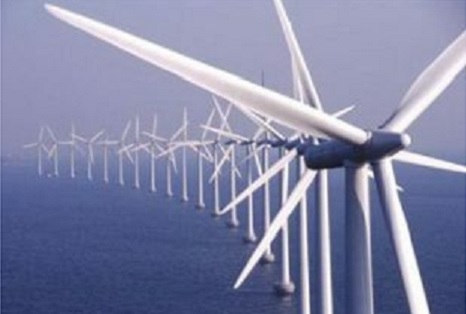
Nils Stolpe: How many statisticians does it take to….
Screw in a lightbulb? Trivialize the deaths of at least two dozen whales? Convince the world that the massive installation of wind power off our East Coast won’t irreparably damage our estuarine, inshore and offshore ecosystems? The folks at NOAA/NMFS (and with the convenient parroting of myriad so-called environmentalists, and BOEM, the other part of the federal cheerleading squad selling Ocean Wind as a major solution to our “energy crisis”) have declared that it hasn’t been proven that there aren’t any relationships between the extensive survey work being committed by Big Wind and the associated contractors and the two dozen deaths that have been visited upon several species of whales off New York and New Jersey. What is their proof? Inadequately enough, their “proof” boils down to the fact that they have seen no proof. To my way of thinking, that’s tantamount to convicting someone of murder because there is no proof that he or she isn’t a murderer. But it appears as if, as far as dead whales and President Biden’s and New Jersey’s Governor Murphy’s windmill fantasies are concerned, that’s good enough. At least for NOAA/NMFS, BOEM and a bunch of environmental organizations. Why? >click to read< 09:54
Nils Stolpe: How many statisticians does it take to….
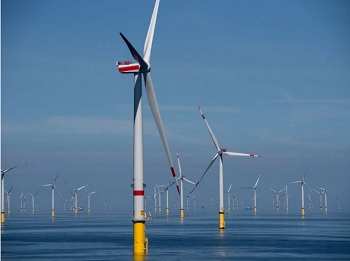 Screw in a lightbulb? Trivialize the deaths of at least two dozen whales? Convince the world that the massive installation of wind power off our East Coast won’t irreparably damage our estuarine, inshore and offshore ecosystems?
Screw in a lightbulb? Trivialize the deaths of at least two dozen whales? Convince the world that the massive installation of wind power off our East Coast won’t irreparably damage our estuarine, inshore and offshore ecosystems?
The folks at NOAA/NMFS (and with the convenient parroting of myriad so-called environmentalists, and BOEM, the other part of the federal cheerleading squad selling Ocean Wind as a major solution to our “energy crisis”) have declared that it hasn’t been proven that there aren’t any relationships between the extensive survey work being committed by Big Wind and the associated contractors and the two dozen deaths that have been visited upon several species of whales off New York and New Jersey. What is their proof? Inadequately enough, their “proof” boils down to the fact that they have seen no proof. To my way of thinking, that’s tantamount to convicting someone of murder because there is no proof that he or she isn’t a murderer. But it appears as if, as far as dead whales and President Biden’s and New Jersey’s Governor Murphy’s windmill fantasies are concerned, that’s good enough. At least for NOAA/NMFS, BOEM and a bunch of environmental organizations.
Why?
Let’s say that you have a degree or two in some academic discipline for which the vast majority of jobs are in the public sector. And that you have a job in a public agency. Particularly in today’s and almost undoubtedly in tomorrow’s economies you probably want to hold onto that job as tenaciously as you can. In the bureaucratic world that means, as Jim Croce sang, “you don’t tug on superman’s cape. You don’t spit into the wind. You don’t pull the mask off that old lone ranger. And you don’t mess around with Jim” (or Phil or Joe).
In other words, a state-level bureaucrat is going to have a rougher time of it if he rains on Governor Phil Murphy’s parade and ditto for a federal bureaucrat and President Joe Biden’s parade. Ditto for college/university researchers and grant getting.
If you’re aware of the fervor with which whale “protectors” flock to, beat their collective breasts over, and publicize each unfortunate whale demise, you probably believe that, at least in the case of the United States, each of those deaths is brought to the attention of what are considered whale/marine mammal “authorities;” that the condition of each mortality is recorded; that the cause of each mortality is determined at best or, at the least, estimated; and that this information is collected and analyzed by educated, trained and supervised public agency personnel. The marine mammal equivalent of the county medical examiner that Jack Klugman portrayed in the long running (8 seasons) NBC series Quincy, M.E. (and described on the IMDB website as “The cases of a brilliant, if Irascible, coroner who investigates suspicious deaths that usually suggest murder.” That would be just about all a dead whale-or a serious, committed environmentalist-could hope for.
Unfortunately, in the real world the best that a dead whale gets doesn’t quite measure up to what Jack Klugman offered to the victims of accused (or convicted) murderers.
If this were the best of all possible worlds, a Jack Klugmanish individual with the necessary mental ability, degrees, licenses, certifications and supervision would be the person working on dead whales. She or he would be working on them as soon after death as possible, performing a complete autopsy (if necessary, down to the cellular level), and filing a publicly accessible, carefully designed, standardized report of the necroscopy within an appropriately brief period after the whale’s death. And each report would be readily publicly accessible.
The cost per dead whale would be affordable, and it could also be done expeditiously. In the greater scheme of (government) things It wouldn’t take very much to move three or four technicians and their equipment anywhere on the East coast in a matter of hours. Possibly costing on the order of a few thousands of dollars.
The Marine Mammal Protection Act (https://www.fisheries.noaa.gov/national/marine-mammal-protection/marine-mammal-protection-act) and the Endangered Species Act (https://www.epa.gov/laws-regulations/summary-endangered-species-act) certainly empowers NOAA/NMFS to be extremely aggressive and maybe even profligate when it comes to protecting cetaceans in general and whales in particular. And their personnel almost invariably are. But it seems that when it comes to whales in New York’s and New Jersey’s waters they have been uncharacteristically meek, mild and circumspect. Making this particularly hard to understand is the severe and growing public angst each dead whale creates, and the economic impact that these mortalities have already had-minimal at this point because they have been in the “off” season-and could continue to have on the two states’ coastal economies.
It appears as if in the world of the MMPA/ESA bureaucrats virtually anybody who has an interest in whales, has some available time and an unfulfilled wish to take a machete to a dead or dying critter that’s been floating in the ocean for some indeterminate length of time and might well have been driven over or run into by unknown vessels either pre- or post mortem, will be welcomed aboard. The assumption is that a follow-up report, which generally remains inaccessible to the public, will be filed though treated as confidential by the marine mammal protection people.
And then, on the political/bureaucratic side, we have the defenders of New Jersey Governor Phil Murphy’s “damn the whales, full speed ahead” approach to the protection and preservation of New Jersey’s irreplaceable inshore and offshore waters and the critters that call them home, (NJ Board of Public Utilities President and Governor Murphy Appointee Joseph) “Fiordaliso also disputed any link between whale deaths and the offshore wind sector, noting experts have yet to find any conclusive evidence tying the problem to the industry.*” Mr. Fiordaliso’s disputation, eerily similar to the comments of every other supporter of the windustrialization of our oceans, relies on the fact that “we have yet to find any conclusive evidence tying the problem to the (wind) industry.” Note that neither Mr. Fiordaliso nor other so-called experts-whether career federal/state agency scientists/bureaucrats or wind energy sycophants that I am aware of-have definitively stated that any institution, agency or individual has in hand conclusive evidence as to what is actually killing the whales.
But they are all, individually and collectively, willing to endorse nothing more than a belief that that conclusive evidence, though up until now elusive, is out there.
Pity the poor whales. But pity even more the hapless scientists and bureaucrats who evidently feel compelled to publicly agree with Governor Murphy’s and President Biden’s fantasies of unlimited cheap electricity at the expense of our estuarine and ocean ecosystems. And that this is more than enough justification for possibly damning the whales.
*Try substituting here “…noting experts have yet to find any conclusive evidence proving the accused murderer is innocent.”
I’ll note here that a seeming lull in New Jersey/New York whale deaths proves nothing more than the “fact” that we know as little about the spate of excessive strandings today as we did when the whales started to die. By no stretch of anyone’s imagination (excluding, of course, personnel at NOAA/NMFS and BOEM, and members of the ENGO seismic profiling deniers club) should this be proof of anything other than fact that we don’t have a clue as to the cause of what is a still an unexplained unnatural phenomenon.
New Jersey Congressman Jeff Van Drew held an investigative hearing, AN EXAMINATION INTO OFFSHORE WIND INDUSTRIALIZATION, in Wildwood, NJ on March 17. The hearing was extremely well attended, with many concerned people turned away at the door. The panel of experts, Congressional Members present, and the audience were overwhelmingly in favor of a thorough investigation of what sounded like bureaucratic/political shenanigans before the state of New Jersey and the Biden administration allows any offshore wind energy development. Interestingly the proponents of this wind energy development are trying, futilely it seems, to connect the rapidly increasing opposition to the irresponsible installation and operation of wind-driven generators with the fossil fuel industry.
A video of the hearing is available at https://tinyurl.com/7zmt4z5e starting at 26:21.
Sign a Change.org petition demanding a temporary delay in and an investigation into Governor Murphy’s/President Biden’s seriously misguided attempts to fill our inshore and offshore waters (and adjoining wetlands) with thousands of these 1,000-foot-tall monstrosities and the associated infrastructure. To sign on go to https://www.change.org/p/
Thank you for your time and attention,
Nils E. Stolpe

Looking Back: Nov.7, 1998 – “Conflict of interest, and fishery management”, By Nils Stolpe
This Looking Back features Nil’s insightful research into the funding source of fishery management bodies in the USA. This article was written in 1998, and the funding sources are still the same, although the monetary amounts are certainly different now. In light of the recent ASMFC /MAFMC allocation steal, covered in dec 20th posting on Fisherynation by Jim Lovgren, [who mistakenly stated that the management funding was by SK money, which is an import-based tax, it is actually Wallop-Breaux funding which is the tax on recreational gear and fuel]. This issue needs to see the light of day again, the conflict is clear, and now they’re using bad science against us. >click to read< 18:35
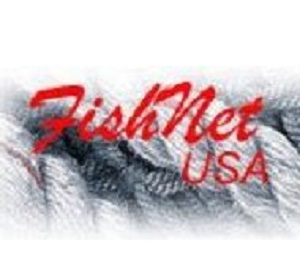
It’s Not Just Windmills – Nils Stolpe
Demand for undersea cables will only grow as more businesses rely on cloud computing services,,, “All of that data is going in the undersea cables.” I have known Captain Jim Lovgren for most of thirty years. I have worked with him on a number of issues,,, Based on this I have no compunctions about strongly recommending that you read the piece that he wrote and titled, “Its Time For A Fishing Industry Buy Out By Offshore Wind” And, unfortunately, I see the struggle that both recreational and commercial fishermen are facing with myriad huge windmills planned in our coastal waters as only the tip of the iceberg. >click to read, with links< 20:51
It’s Not Just Windmills – Nils Stolpe
© 2021 Nils E. Stolpe – FishNet USA/ April 12. 2019
Demand for undersea cables will only grow as more businesses rely on cloud computing services. And technology expected around the corner, like more powerful artificial intelligence and driverless cars, will all require fast data speeds as well. Areas that didn’t have internet are now getting access, with the United Nations reporting that for the first time more than half the global population is now online.
“This is a huge part of the infrastructure that’s making that happen,” said Debbie Brask, the vice president at SubCom, who is managing the Google project. “All of that data is going in the undersea cables.” (How the Internet Travels Across Oceans, Adam Striano, NY Times, 03/10/2019, https://www.nytimes.com/interactive/2019/03/10/technology/internet-cables-oceans.html)
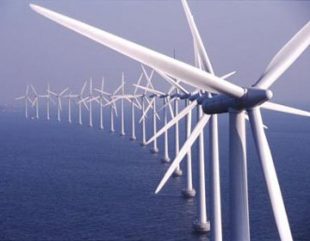 I have known Captain Jim Lovgren for most of thirty years. I have worked with him on a number of issues and have grown to respect both his intelligence and his ability to get to the heart of a problem without getting sidetracked by what are generally minor distractions. Based on this I have no compunctions about strongly recommending that you read the piece that he wrote and Borehead has published on his website http://www.FISHERYNATION.com titled, “Its Time For A Fishing Industry Buy Out By Offshore Wind” >click to read<, (and while I’m at it I’ll also recommend that if you don’t already you should immediately subscribe to FisheryNation as well. Borehead publishes material that, while it is sometimes controversial, is generally on target and not reflective of the overly-cautious perspective that seems to be plaguing other commercial fisheries publications.)
I have known Captain Jim Lovgren for most of thirty years. I have worked with him on a number of issues and have grown to respect both his intelligence and his ability to get to the heart of a problem without getting sidetracked by what are generally minor distractions. Based on this I have no compunctions about strongly recommending that you read the piece that he wrote and Borehead has published on his website http://www.FISHERYNATION.com titled, “Its Time For A Fishing Industry Buy Out By Offshore Wind” >click to read<, (and while I’m at it I’ll also recommend that if you don’t already you should immediately subscribe to FisheryNation as well. Borehead publishes material that, while it is sometimes controversial, is generally on target and not reflective of the overly-cautious perspective that seems to be plaguing other commercial fisheries publications.)
If you follow what I write in FishNet-USA, you know that I have been concerned about the potential impacts of wind power development on our coastal waters, and of the critters that you catch that live in those waters, for years. That concern is based on a significant amount of research done by extremely credible scientists, but is too often ignored by bureaucrats, by politicians and by the so-called environmentalists who are seemingly blinded by the “something for nothing” allure of wind power. This is exacerbated by the sense of impending doom that has been part and parcel of what is largely a Chicken Little-like approach of the national print, broadcast and social media outlets to climate change.
And, unfortunately, I see the struggle that both recreational and commercial fishermen are facing with myriad huge windmills planned in our coastal waters as only the tip of the iceberg.
The oceans have been “up for grabs” for generations, but the current crop of grabbers are a passel of high tech billionaires with unimaginable wealth and power who recognize the inherent technological, sociological and economic limitations of land-based and space-based telecom expansion.
But the oceans are out there, they offer unsurpassed access to the major population centers that are and will continue to be the focus of telecommunications growth, and the only other groups that have major claims upon their use are fishermen (and the world’s navies, but unlike most of our elected officials, at least for now they are beyond the reach of Silicon Valley). And as an aside, guess where the major funding of efforts to delegitimize our claims has come from.
And don’t forget the allure of free cooling. All of that cold water just waiting for our modern robber barons to put it to use. And aquaculture. And kelp farming. And the list goes on and on.
So, if you are looking for a comfortable future in commercial fishing take Jim Lovgren’s words seriously. Consider them, discuss them with your colleagues and accept the fact that, at least in some peoples’ opinion the camel has already gotten its nose in the tent and the rest of him is going to soon follow. But don’t forget that wind power is just a starting point. Over 70% of the earth’s area is covered by oceans. Unutilized (except for fishing) from time immemorial, their many potentialities have been “discovered” by the huge money folks, they are on the cusp of over-exploitation, and your future could easily become a casualty.
For a bit more depth on this issue, see my “Fish Wars” or a Regime Shift in Ocean Governance? On the Fishery Nation site (https://fisherynation.com/fish-wars-or-a-regime-shift-in-ocean-governance). For a comprehensive though somewhat dated look at the world of submarine cables see How the Internet works: Submarine fiber, brains in jars, and coaxial cables – A deep dive into Internet infrastructure, plus a rare visit to a subsea cable landing site in the 5/26/2016 edition of Ars Technica by Bob Dormon https://arstechnica.com/information-technology/2016/05/how-the-internet-works-submarine-cables-data-centres-last-mile/.
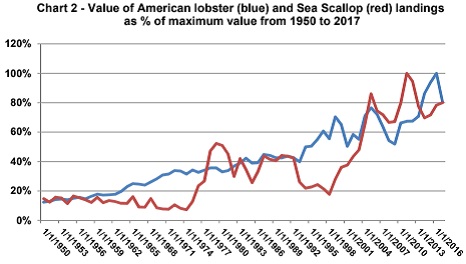
After over forty years of NOAA/NMFS management how are we really doing? Nils Stolpe
The Magnuson-Stevens Fishery Conservation and Management Act – I have seen the focus of government fisheries manage-ment increasingly shift away from the fishermen to the fish. The provisions of the Act as it was originally written were put in place to allow the U.S. fishing industry to regain control of the fisheries in the United States’ highly productive coastal waters,,, The legislation was singularly effective, so effective that within ten years or so of its passage the greatest portion of our domestic fish and shellfish production was being harvested by U.S. fishermen on U.S. vessels. This success was sold to the U.S. public – and the U.S. politicians – as an assault on the “sanctity” of our coastal waters by a burgeoning environmental industry that was (and still is) engaged in non-governmental empire building. This has resulted in a handful of multi-national ENGOs (Environmental Non-Governmental Organizations) that have become at least as influential as the fishing industry in national and international fisheries management. >click to read, and review the links and graphs<16:10
After over forty years of NOAA/NMFS management how are we really doing? Nils Stolpe
Nils E. Stolpe/FishNet USA
© 2019 Nils E. Stolpe
June 1, 2019
After over forty years of NOAA/NMFS management how are we really doing?
I have devoted well over two decades to familiarizing myself with and writing about various aspects of the domestic commercial fishing industry. I hope I’ve done it in a way that provides a reasonable amount of insight into what are large-ly complex and too often confusing issues.
Since being involved in the industry – and this involvement goes as far back as the passage of what is now called the Magnuson-Stevens Fishery Conservation and Management Act – I have seen the focus of government fisheries manage-ment increasingly shift away from the fishermen to the fish. The provisions of the Act as it was originally written were put in place to allow the U.S. fishing industry to regain control of the fisheries in the United States’ highly productive coastal waters, fisheries which had been for the most part taken over by the distant water fleets of other fishing nations.
The legislation was singularly effective, so effective that within ten years or so of its passage the greatest portion of our domestic fish and shellfish production was being harvested by U.S. fishermen on U.S. vessels.
This success was sold to the U.S. public – and the U.S. politicians – as an assault on the “sanctity” of our coastal waters by a burgeoning environmental industry that was (and still is) engaged in non-governmental empire building. This has resulted in a handful of multi-national ENGOs (Environmental Non-Governmental Organizations) that have become at least as influential as the fishing industry in national and international fisheries management.
With huge staffs and huge public relations budgets they have successfully shifted the focus from profitably harvesting to sustainably harvesting fish
and shellfish.
This shift in focus is nowhere more obvious than in the Annual Report to Congress on the Status of U.S. Fisheries (the most current Report, for 2017, is available at http://tinyurl.com/yc7ufkal).
A check on the web shows that the term “fishery” includes the fish (or shellfish), their habitat, the people who catch (or grow) them, and what they use to capture (or grow) them is accurate. According the Merriam-Webster online dictionary the definition of “fishery” is:
1 – The occupation, industry, or season of taking fish or other sea animals (such as sponges, shrimp, or seals
2 – A place for catching fish or taking other sea animals
3 – A fishing establishment – also its fishermen
4 – The legal right to take fish at a particular place or in particular waters
5 – The technology of fishery —usually used in plural
According to the folks at Merriam-Webster, as well as the fish or other sea animals a fishery includes the people who catch them and all of the other mechanisms, legislation, and institutions that allow them to be caught.
Yet according to NOAA/NMFS, the status of our fisheries obviously involves only the fish. With over 2,300 words in the 2017 annual report linked above, by my count only 75 of those words did not relate solely to the fish or to the condition of those fish. Those few are:
Combined, U.S. commercial and recreational saltwater fishing generated more than $208 billion in sales and
supported 1.6 million jobs in 2015…. The need to increase our nation’s seafood production is a continuing and
growing challenge…. NOAA Fisheries is focusing on a number of activities aimed at leveling the playing field for
our domestic seafood industry. These include increasing seafood trade opportunities and market access so that
we can remain competitive with other seafood exporting countries….
That’s it!
While this should be slightly less than a surprise to anyone in, associated or familiar with the commercial fishing industry, it’s fairly obvious that the federal agency that is supposedly concerned with the management of all facets – human and piscine – of our fisheries has pretty effective blinders on when it comes to “managing” anything but the fish. And going a step further, that management has as its overriding goal the health (or sustainability if you would rather) of those fish. The rest, which should include the welfare of the fishermen and all of the businesses that are directly or indirectly fisheries dependent, doesn’t matter to NOAA/NMFS – and apparently NOAA/NMFS has decided that it shouldn’t matter to Con- gress – or to the citizens of the U.S. – either.
So Congress gets an annual rundown on the well-being, by species and en masse, of the fish in U.S. waters and virtually nothing about the well-being of the other components of the fisheries; the people who and the businesses that catch, pro- cess, buy, sell and eat them.
In light of this (purposely?) myopic vision of our fisheries, how are we to gauge how well the people at NOAA/NMFS are doing one of their primary jobs, managing our fisheries, by using a more inclusive definition of the term? I doubt that anyone reading this would be surprised by the answer “not so easily.”
Each year NOAA/NMFS also publishes Fisheries of the United States, the most recent being for 2017 (http://tinyurl.com/y5e8sjy6). In the words of NOAA/NMFS:
Fisheries of the United States, published each fall, has been produced in its various forms for more than 100 years. It is the NOAA Fisheries yearbook of fishery statistics for the United States. It provides a snapshot of data, primarily at the national level, on U.S. recreational catch and commercial fisheries landings and value.
In addition, data are reported on U.S. aquaculture production, the U.S. seafood processing industry, imports and exports of fishery-related products, and domestic supply and per capita consumption of fishery products. The focus is not on economic analysis, although value of landings, processed products, and foreign trade are included.
Each annual Fisheries of the United States report contains a wealth of information on commercial landings for the year of publication and the previous year (i.e. the 2017 report has commercial landings for 2017 and 2016) and in a few in- stances goes back slightly farther.
However, a one or two year snapshot doesn’t show much about fisheries trends, or about the success – at least from a fishing industry perspective – of management efforts. And said most simply, though anti-intuitively, the status of the fish stocks no longer has an awful lot to do with the status of the human components of the fishery.
But, and this might come as surprise to most federal and state fisheries managers, there are other measures of how well they are doing at managing our fisheries, and among the most important is – or should be – how well the fishermen and those in fishing dependent businesses, who once were supposed to be much of the reason for spending hundreds of millions of taxpayer dollars each year on fisheries management, are doing.
When is the last time that anyone from the Fed asked you how you were doing? And when was the last time that you saw any federal pronouncements dealing with how well the fishermen, the lumpers, the processors, the sellers, the truckers or anyone else whose life depends on fishing, were doing?
So why all of the graphs going back to 1950?
There are unquestionably a number of ways in which the success/satisfaction of people in the fishing industry can be measured. I’ve picked, however, the most simple; the value of annual landings in a particular fishery compared to the value of previous years’ landings in that fishery.
Particularly in this age of limited access, the luxury of being able to switch to other fisheries is one that only a very few fishermen can afford. Hence what you “earned” in prior years in a particular fishery should generally be a reasonable measure of how well you’ve done subsequently. (The volatility in the price per pound in some fisheries makes the weight of fish landed less important to the fishermen than the value of their catch. The generalization that most fishermen are fishing for money is usually accurate.)
Accordingly I looked at the catch value estimates from the NOAA/NMFS Commercial landings database at https://www.st.nmfs.noaa.gov/commercial-fisheries/commercial-landings/annual-landings/index. To allow realistic year-to-year comparisons, I corrected the value of each year’s landings for inflation, expressing them in 2017 dollars by using the US inflation calculator at https://www.usinflationcalculator.com/. All of the graphs were done with Microsoft Excel 2010. (Initially I’m limiting this to Atlantic coast landings. The same data is available for the Gulf of Mexico, Pacific and Alas-
ka fisheries but I’ll keep an Atlantic focus here.)
The total value of Atlantic commercial landings was determined by multiplying the annual values of “All Species Combined” from each year from 1950 to 2017 by the appropriate inflation correction. The value of all species combined in 1950 was three hundred and thirty-six million dollars, which using the inflation calculator linked above yields the equivalent of three billion four hundred and twenty million dollars in 2017.
Because I am comparing individual fisheries that had annual landings ranging from hundreds of thousands to hundreds of millions of dollars, I graphed annual landings (of individual fisheries as well as total fisheries combined) as a percentage of the maximum landings. For example, the inflation corrected maximum value of all landings was $2,249,921,045 in 1979, represented by 100% in Chart 1. It was $1,969,770,533 in 2017, 88% of the maximum.
The average for total Atlantic landings from 1950 to 2017 when corrected for inflation was $1,888,500,000, which was below the 2017 landings maximum. All things considered, in 2017 being 4% above the yearly average value of landings since well before Magnuson management began (the Act became law in 1976) seems fairly decent management performance.
But unfortunately for many fishermen and people in fishing dependent businesses, the devil is in the details, and not too surprisingly – at least to those of us familiar with the commercial fishing industry on the East coast – those details present a picture much less rosy than the bigger picture up above.
As Chart 2 below shows, The American lobster and sea scallop fisheries, currently the two most valuable fisheries on the
East coast, when corrected for inflation have each more than doubled in value since the passage of the Magnuson Act.
 Conversely the combined landings in all of the other fisheries have been just about halved in the same period. As Chart 3 below shows, the booms in the lobster and scallop fisheries haven’t been accompanied by corresponding booms in many of the other fisheries. In fact the situations in some of those fisheries can best be described as busts.
Conversely the combined landings in all of the other fisheries have been just about halved in the same period. As Chart 3 below shows, the booms in the lobster and scallop fisheries haven’t been accompanied by corresponding booms in many of the other fisheries. In fact the situations in some of those fisheries can best be described as busts.
Chart 3 shows the value of all Atlantic coast landings minus lobsters and sea scallops. This indicates a relatively steady decline since the peak of one point six billion dollars (inflation corrected) in 1979. The minimum of seven hundred and sixteen million dollars was landed in 2009 and there has been a slight increase since then, but in 2017 landings minus sea scallops and lobster were less than 60% of what they were at their peak.
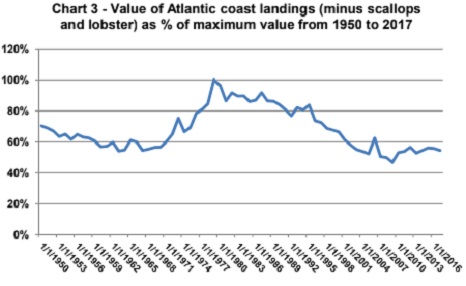 These two charts tell a fairly sad story about most of the Atlantic coast commercial fishing industry since the passage of the Magnuson Act, at least as far as the “management” part is concerned. Thanks to a fortuitous confluence of factors, what were the two most valuable fisheries on the U.S. east coast were still the most valuable in 2017 and their relative values have more than doubled, but for most of the other fisheries this is far from case.
These two charts tell a fairly sad story about most of the Atlantic coast commercial fishing industry since the passage of the Magnuson Act, at least as far as the “management” part is concerned. Thanks to a fortuitous confluence of factors, what were the two most valuable fisheries on the U.S. east coast were still the most valuable in 2017 and their relative values have more than doubled, but for most of the other fisheries this is far from case.
Below are charts for the twenty four Atlantic coast fisheries that were most valuable Atlantic coast fisheries – both finfish and shellfish – in 2017 (the catch-all category “Shellfish,” which was the 15th most valuable, was omitted). Of the seventeen most valuable finfish fisheries, the value of three relatively minor commercial fisheries – striped bass,
American eel and black sea bass – have had landings that have increased in value since the passage of the Act, and “modern” fisheries management began in the late 1970s. The remaining fourteen have decreased in value, and most have in fact plummeted.
Of the thirteen shellfish fisheries only six could be described as plummeting in value, the other seven appearing to have increased significantly (though the two squid fisheries and the Jonah crab fisheries are new fisheries which were insignificant pre-Magnuson).
(Note that the reported value of the Atlantic herring catch from 2004 to 2006 appear to be anomalous. However, my query to NOAA/NMFS regarding possible reasons for this wasn’t responded to. I have also included several species which, while “historically” important were no longer in the most valuable 25 fisheries in 2017.)
Does this bode well for our Atlantic fisheries? Not hardly. Two fisheries are accounting for about 50% of the total value of landings. What’s going to happen if either the sea scallop or the lobster fishery suffers a significant setback? How much of the Atlantic coast commercial fishing infrastructure depends on the continued success (and growth?) in these two fisheries, and do any alternatives exist if they become necessary?
So while it’s well and good that the Federal agency that is charged with managing our fisheries is becoming fairly proficient at blowing its own horn (see The Surprising Story of Swordfish You May Not Know at https://www.fisheries.noaa.gov/feature-story/surprising-story-swordfish-you-may-not-know, though I have to wonder why it took over twenty years to get this story out) and giving the fishing industry well-deserved and too often long-overdue credit for “above and beyond” conservation efforts*, if at any point the bottom drops out of the Atlantic sea scallop or lobster fisheries, are the people at NOAA/NMFS preparing for such eventualities?
Good for the fish? For sure!
Good for the fishermen (or anyone whose paycheck depends in all or in part on their efforts) or for fresh, local seafood lovers? You be the judge!
*I’ll draw your attention to Atlantic swordfish landings – see Chart 7 above. The maximum inflation corrected
value for domestic landings was almost $105 million in 1992. In 2017 it was down to $17.5 million. The fact is
that recent landings are on the order of less than 20% of what they were during the peak years of the fishery, and
yet the fishery is being considered – by NOAA/NMFS, the responsible management agency – as a management
success. And similar plunges from record landings values in the first years of Magnuson management to 25% or
less of the post-Magnuson maximum is seen in Atlantic coast fishery after fishery.
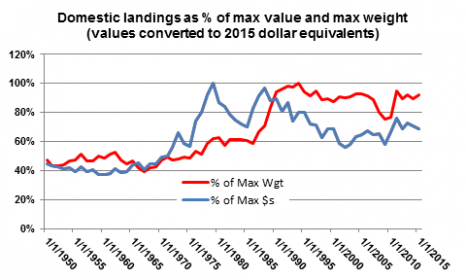
Nils Stolpe, Fishnet USA – So how are we doing? (2017 edition) A Report on our Domestic Commercial Fishing Industry
I occasionally share my impressions of how the domestic commercial fishing industry is doing, using as my primary data source the NMFS online database “Annual Commercial Landing Statistics” (click here). We are fortunate to have these extensive records of commercial landings of fish and shellfish in the United States extending back to 1950 because they allow a fairly comprehensive view of long term industry (and resource) trends. Among the most useful statistics are those dealing with the value and weight of the total landings for each year. Together they give an overview of how the domestic fishing industry is progressing (or regressing) from year to year. Click here to read the report 11:49
Nils Stolpe – So how are we doing? (2017 edition) A Report on our Domestic Commercial Fishing Industry
 June 30, 2017 Nils Stolpe, www.fishnetusa.com
June 30, 2017 Nils Stolpe, www.fishnetusa.com
I occasionally share my impressions of how the domestic commercial fishing industry is doing, using as my primary data source the NMFS online database “Annual Commercial Landing Statistics” at https://www.st.nmfs.noaa.gov/commercial-fisheries/commercial-landings/annual-landings/index.We are fortunate to have these extensive records of commercial landings of fish and shellfish in the United States extending back to 1950 because they allow a fairly comprehensive view of long term industry (and resource) trends.
Among the most useful statistics are those dealing with the value and weight of the total landings for each year. Together they give an overview of how the domestic fishing industry is progressing (or regressing) from year to year. I’ve tried to incorporate that in the chart below, but rather than using the specific weights and dollars I converted them to the percentages of the maximum weights and dollars (and corrected the value of landings for each year for inflation using the US Inflation Calculator at http://www.usinflationcalculator.com/). As an example, the cumulative rate of inflation between 1950 and 2015 is 983%. Thus the $336,266,187 of fish and shellfish landings reported in 1950 was worth $3,307,087,254 in 2015 dollars.
From a weight-of-landings perspective it looks as if the commercial fishing industry nationally isn’t doing too badly. Unfortunately that isn’t the case from an income perspective, with recent landings being in the range of from under 60% to approaching 80% of 1979, the peak year for value of landings (at almost $4.5 billion when adjusted for inflation).
Each year’s weight and (corrected) value is represented by its percentage of the maximum weight (4,752,254 metric tons in 1994) and maximum value ($7,418,658,938 in 1979). This allows for fairly accurate year-to-year comparisons.
At the macro-level this chart shows that U.S. commercial landings have dropped in the neighborhood of 5% below their maximum level of production in 1994. However, the value of those landings appears to have declined at a significantly greater rate. The value of the landings in the year with the peak weight was only 80% of the maximum value of landings, and that relationship appears to have continued and for the most part increased. It’s safe to say that over the last quarter of a century domestic fishermen have been catching more for a significantly smaller return.
This could at least partially be a function of a relative increase in the production of lower value fish, or of market pressures (as it’s illustrated below, consider the extraordinary growth of the domestic tilapia demand and its possible market impacts on domestically produced seafood).
(From Fitzsimmons, K., Tilapia Aquaculture 2016, Eleventh International Symposium on Tilapia in Aquaculture, https://cals.arizona.edu/azaqua/ista/ISTA11/ISTA11.htm),
But of course the national performance doesn’t mean much to the many businesses that are dependent on one or several fisheries.
Getting more specific, I have charted the weight and inflation adjusted value of the twenty-five most valuable domestic fisheries as of 2015. To list them in order of descending value, they are American lobster, walleye pollock, sea scallops, Pacific cod, blue crabs, sockeye salmon, eastern oysters, Atlantic menhaden, snow crabs, pink salmon, Pacific halibut, sablefish, Dungeness crabs, king crabs, bigeye tuna, chum salmon, chinook salmon, Pacific geoducks, northern quahogs, spiny lobsters, Atka mackerel, tanner crabs, Pacific oysters, stone crab (claws) and yellowfin sole (all of these charts are available in a Adobe Acrobat document at http://www.fishnet-usa.com/Top25Fisheries_2015.pdf).
Thus, Atlantic menhaden, one of our largest fisheries, had maximum landings of 1.36 million metric tons in 1983 valued at 290 million dollars (in 2015 dollars) while the maximum value landed was in 1973 for 850 thousand metric tons valued at just over $400 thousand (again in 2015 dollars). Atlantic Menhaden Landings in 2015 were 740 thousand metric tons, valued at just under $180 thousand. This was 45% 0f the maximum weight of Atlantic menhaden landed and was worth 54% of the maximum value.
The table below lists the 25 most valuable fisheries for 1950 (the earliest year for which catch data is available on the Commercial Landings web site), 1980 (post-Magnuson), 2006 (post-SFA) and 2015 (the most recent year with landings data available). The landed value is reported for the particular year as well as that value adjusted for inflation (“2015 Value”). Ten fisheries have consistently been in the top twenty-five. These are in colored cells.
(Note that because of naming inconsistences the various shrimp groups were omitted. Among our most valuable fisheries, if they were included a number of them would have been listed in the top 25 for at least one of the four years and several for more than one year.)
Looking at the performance of the top 25 fisheries, generalizations seem to be pretty hard to come by. Some are and have be trending upward fairly steadily since the fishery began (bigeye tuna, American lobster), some trending steadily downward (Eastern oysters until oyster aquaculture got serious, king crab since the peak production), many a significant decline in the last decade or so
(Dungeness crab, king crab, chinook salmon, northern quahogs, sablefish, halibut), and others are impossible to categorize, seeming to vary randomly. If only the last ten years – since the SFA was passed, it appears to be about a tie between winners and losers (with the winners slightly in the lead) as far as production is concerned.
The chart below indicates the great range in the value of landings in the four years selected in various “top 25” fisheries. Note that the 1950 value was at or approaching peak levels in six fisheries as it was in the immediate post-Magnuson period (1980). The wide variations could be caused by resource/environmental, economic or political factors, or any combination, but they make clear the lack of stability in many of our fisheries – and are a good argument for the difficulty (futility?) of attempting to manage for anything like a “constant harvest” unless the harvest is reduced to such an extent that natural cycling becomes the overwhelmingly dominant population determinant.
The situation in the Mid-Atlantic
I treated what I consider the fourteen major ocean-based fisheries in the Mid-Atlantic region as I did the national “top 25.” Then I went one step beyond that and graphed only the last ten years – again as percentages of the peak production of each fishery since 1950. I also included linear trend lines for both the weight and the (inflation corrected) values of the landings. The values of landings are in blue and the weights in red (go to http://www.fishnet-usa.com/MidAtlanticFisheries_2015.pdf).
Eight of the fourteen fisheries have had both production and value trending down for the past decade and two, sea scallops and loligo squid, haves had production heading down but value increasing. Considering the ongoing major cuts in the summer flounder TAC I have no doubt that as soon as the 2016 landings are included they will be heading downward as well. Over 70% of the Mid-Atlantic fisheries will be in a state of decline.
So what does this all mean?
Beyond what seems to be the inescapable conclusion that if maximizing production is the goal we aren’t doing a particularly good job managing our fisheries, at this point your guess is at least as good as mine. Based on what seemed to be some inconsistencies in summer flounder trawl survey/landings data post-SFA (see https://fisherynation.com/58407-2), over the next month I am planning on examining how indices of abundance (aka surveys) relate to landings in particular fisheries – again with a focus on Mid-Atlantic/Northeastern fisheries. Perhaps this additional data will contribute to a more clear picture of what’s going on in some of our fisheries and in their management.
____________________
In 2015 the National Marine Fisheries Service Commercial Landings database reported on 485 species/fisheries. The most valuable of these fisheries, that for American lobster, landed 66,500 metric tons worth $620 million at the dock. The least valuable, that for leather skin (https://www.tradeindia.com/fp474459/Leather-Skin-Fish.html), reportedly landed 4 pounds worth $8. The walleye pollack fishery, the largest in 2015, produced over 3.2 billion pounds. The leather skin made the list as the smallest fishery as well. Domestic fisheries may be managed by international organizations, tribal councils, federal, state or local agencies, or combinations of these groups. Domestic fish and shellfish can be caught by multi-million dollar state-of-the-art fishing vessels or folks slogging around on mud flats with shovels and buckets (I have no idea how the 4 pounds of leather skin were caught). The landed value of domestically produced fish and shellfish ranges from pennies to tens of dollars per pound (the 2.6 million pounds of Pacific geoduck returned $56 million to the producers). And there is – to me, at least – a surprising inconsistency in year-to-year landings in virtually all fisheries.
The domestic commercial fishing industry could best be described as diverse, and deciding how to characterize its performance over time was a bit of a challenge. Taking into account the fact that in 2015 the 25 most valuable fisheries accounted for 78% of the value of the total landings, I decided to focus on these top fisheries. Considering that the weight produced in particular fisheries could vary by several orders of magnitude compared to other fisheries, the weights landed are expressed as percentages of the maximum landed weights reported. All of the landings values have been corrected for inflation, using 2015 equivalents and are also presented as percentages of maximum (corrected) value. This should allow for useful year-to-year comparisons within and between particular fisheries.
The Excel spreadsheet containing all of the data I used for this FishNet is just under a megabyte in size. If you wish a copy, email me at [email protected].
Nils Stolpe: What’s so hard about managing fisheries?
 Nils Stolpe/FishNet USA May 3, 2017
Nils Stolpe/FishNet USA May 3, 2017
“We live in a world in which data convey authority. But authority has a way of descending to certitude, and certitude begets hubris. From Robert McNamara to Lehman Brothers to Stronger Together, cautionary tales abound. We ought to know this by now, but we don’t. Instead, we respond to the inherent uncertainties of data by adding more data without revisiting our assumptions, creating an impression of certainty that can be lulling, misleading and often dangerous. Ask Clinton” Stephens, B., Climate of Complete Certainty, NY Times, 4/28/17.
The above quote was from an op-ed piece by Bret Stephens, the New York Times’ recently acquired columnist. While he was targeting climate scientists, their “disciples” and the overblown pseudo-science hidden beneath an oversufficiency of less than convincing statistics that is used to strengthen their arguments, it appears that fisheries scientists are increasingly adopting the same techniques (the emphasis is mine) to support their often erroneous – sometimes sadly so – conclusions.
“NMFS proposes revised black sea bass specifications for the 2017 fishing year and projected specifications for 2018. In addition, this rule proposes to remove an accountability measure implemented at the start of the fishing year designed to account for commercial sector overages in 2015. Updated scientific information regarding the black sea bass stock indicates that higher catch limits should be implemented to obtain optimum yield, and that the accountability measure is no longer necessary or appropriate…. The (Mid-Atlantic Fishery Management) Council and the (Atlantic States Marine Fisheries) Commission’s Summer Flounder, Scup, and Black Sea Bass Management Board met jointly on February 15, 2017, to consider the SSC and Monitoring Committees’ recommendations…. The Council’s recommendations represent a 53-percent increase in the 2017 commercial quota established in 2015 and a 52-percent increase in the 2017 recreational harvest limit. (from Fisheries of the Northeastern United States; Black Sea Bass Fishery; 2017 and Projected 2018 Specifications, Federal Register / Vol. 82, No. 71 / Friday, April 14, 2017 / Proposed Rules).
The above adjustment would apply to black sea bass, an important commercial and recreational fishery in the Mid-Atlantic. When it is implemented the value of the commercial black sea bass fishery in the Northeast, based on 2015 across-the-dock prices, would be in the neighborhood of $15 million. In 2015 the value of the commercial black sea bass fishery in the Northeast was approximately $4.5 million. Before the results of the new stock assessment, the impetus for the above adjustment, were available the commercial landings for 2017 were set to be under $7 million.
The recreational fishery will get a comparable increase.
Summer flounder, black sea bass and scup are all managed under the same fishery management plan, which with amendments has been going on for almost 30 years.
Last autumn I described in Summer Flounder Management – Can it get any worse? (available at http://www.fishnet-usa.com/SummerFlounder_AnyWorse.pdf) how another important mid-Atlantic fishery over the same period was subject to a greater than 50% quota cut over a two year period. And, like the black sea bass quota, though with much less desirable results, the quota change was mandated with minimal lead time.
Imagine what the effects of these drastic changes in supply in these fisheries have been/will be on the people, the businesses and the communities that depend on them. I doubt that the federal government could come up with any other management strategy, short of an out and out harvest moratorium, that would be more damaging to fishing and fishing dependent businesses. Successful businesses depend on predictability; predictable supplies at predictable prices and with predictable markets, and in fisheries the federal government has been far to capable of delivering unpredictability since the passage of the Sustainable Fisheries Act in1996. In certain fisheries unpredictability seems to be the rule rather than the exception.
Fisheries management minus the overblown science, bureaucratic bluster and ENGO manipulation
In theory, there’s not much involved in effective fisheries management. All that’s required is the wherewithal to accurately estimate the condition of the fish/shellfish stock or stock complex you are managing on an annual basis, an accurate determination of the fishing mortality you will allow, and a mechanism to maintain, increase or decrease the mortality level dependent on the following fishing year’s mortality.
Obviously this management scenario assumes that there is a relationship between the status of the stock being managed and the fishing mortality, perhaps not expressed immediately but surely after a lag time of a year or two (arguably that’s not always the case, but that’s a whole other story).
But, as the current summer flounder/black sea bass situation so clearly demonstrates, today this is far beyond the capabilities of our federal fisheries managers and our federal fisheries management system.
Back to summer flounder (yet another Never Ending Story)
Let’s use summer flounder management as an example of what supposed “state of the art” fisheries management looks like. Below I’ve graphed the results of the summer flounder component of the Northeast Spring and Autumn Bottom Trawl Surveys – supposedly one of the best (i.e. most accurate/longest running) fish surveys we’ve got (http://www.nefsc.noaa.gov/publications/crd/crd1221/t36thru37.pdf). I’ve also graphed the summer flounder landings from the NMFS on-line landings database (https://www.st.nmfs.noaa.gov/commercial-fisheries/commercial-landings/) for the past 40+ years. (The commercial landings and the survey results are expressed as percentages of the maximum survey catch – 2008 – and the maximum landings – 1979 – for the period).
Below are charts of landings and survey results in three logical periods based on what have to be considered as revolutionary changes in how we manage or don’t manage fisheries. These are pre-Magnuson (Figure 1 below), post-Magnuson/pre-Sustainable Fisheries Act (Figure 2) and post-Sustainable Fisheries Act (Figure 3). Blue are survey samples (as the % of the maximum survey sample weight in the respective period) and red are landings (as the % of the maximum landings weight in the respective period).
Using linear trend lines a la MS Excel, there appear to be relationships between the bottom trawl survey results and harvest for summer flounder prior to the passage of the Magnuson Act in 1976 (survey catch and commercial landings both increase) and post-Magnuson/pre Sustainable Fisheries Act (survey catch and commercial landings both decrease). In the period following the passage of the Sustainable Fisheries Act in 1996 the survey results increase dramatically while commercial landings remain flat.
Since the beginning of the annual Northeast bottom trawl surveys and commercial landings tracking began (at least until the Sustainable Fisheries Act was passed in 1996) there’s been an apparent relationship between the estimated summer flounder population size and the harvest. At first – Fig. 1 above – from 1968 to 1975 and with minimal management measures, the population increased and the landings increased correspondingly. Then in 1976 – Fig. 2 – with the advent of Magnuson management and with an increase in effort that came about in just about every federally managed fishery because of its provisions, the population decreased and the landings followed suit. That’s the way it’s supposed to work. But as Fig. 3 above indicates, since the SFA was enacted it no longer works that way. The weight of the summer flounder sampled, hence the biomass, has increased steadily and seemingly consistently in spite of the switch from the R/V Albatross to the R/V Bigelow, yet landings have remained flat.
(I’ll note here that I have had a request in to the survey people at the NOAA/NMFS Northeast Fisheries Science Center for two months or so for survey results for other northeastern fish species but have yet to receive anything in return other than an acknowledgement that the request was received.)
While it might be ill-advised to generalize from a single FMP, some things seem apparent
First off, and possibly most importantly, after the passage of the Magnuson-Stevens Act and before the passage of the Sustainable Fisheries Act (SFA) the Regional Fisheries Management Councils had significant latitude in interpreting the information that was presented to them from the scientific/academic community and the “anecdotal” input from people knowledgeable in fisheries on both sides of the Council table. On-the-water observations and (sometimes multi-generational) knowledge wasn’t automatically discounted as it is far too often of late. The Councils’ job was to consider all of the information presented to them and to determine their management strategy accordingly (bear in mind that both then and now the Councils only made/make recommendations to the Secretary of Commerce, who has been and still is ultimately responsible for management decisions).
Since 1996 and the SFA, management has been completely different – though as Fig. 3 above seems to indicate, it certainly hasn’t been more effective, at least from what used to be the acceptable “if there are more fish, fishermen should be allowed to catch more” pre-SFA perspective. Now scientists have much more input and much more influence, learned judgment, which is still referred to deprecatingly as “anecdotal information” takes a far back seat, and statistics, no matter how inadequate, reign.
Hence the huge, and costly, changes in management parameters based on reassessments and reinterpretations and “uncertainty” penalties. Looking at summer flounder and black sea bass, the scientists appear to be clueless from year to year and yet luxuriate in a system in which the only accountability is borne by the fishermen.
As I have written before, what passes for fisheries management in the U.S. today has been purposefully distorted by anti-fishing activists (misrepresenting themselves as marine conservationists) into a top-heavy bureaucratic system that is focused almost completely on preventing “overfishing,” regardless of the effects this monomaniacal focus has on domestic fishermen and domestic fishing businesses. In the distorted view of these “conservationists,” overfishing should be classified as one of the Cardinal sins, and there should be no acceptable excuse for allowing it to happen in any of our domestic fisheries.
The end result of their successful selling of this view to the unknowledgeable is totally unrealistic harvest restrictions which make it increasingly difficult – and increasingly, impossible – for domestic fishermen to remain in business. And not too surprisingly, of having over 90% of the seafood sold in the U.S. being imported.
To give you an idea of what constitutes federal fisheries management today, the post-SFA managers will start out with the determination of the Overfishing Limit (OFL) in a fishery. The OFL is equivalent to the Maximum Sustainable Yield (MSY), the maximum amount of fish that can be sustainably harvested from a given stock of fish.
But the OFL is then reduced to what is termed the Acceptable Biological Catch (ABC). This is the OFL reduced by “Scientific Uncertainty.”
Scientific uncertainty refers to uncertainty in the information about a stock and its maximum sustainable yield reference points. Sources of scientific uncertainty could include: uncertainty in stock assessment results; uncertainty in the estimates of maximum fishing mortality threshold, maximum stock size threshold, the biomass of the stock, and overfishing limit; time lags in updating assessments; the degree of retrospective revision of assessment results; uncertainty in projections; uncertainties due to the choice of assessment model; longer-term uncertainties due to potential ecosystem and environmental effects; or other factors (http://www.nmfs.noaa.gov/sfa/
management/acls_ams/setting_ acl.html).
Then the ABC is further reduced by management uncertainty to the Annual Catch Target (ACT).
Management uncertainty refers to uncertainty in the ability of managers to constrain catch so that the annual catch limit is not exceeded, and the uncertainty in quantifying the true catch amounts (i.e., estimation errors). The sources of management uncertainty could include: late catch reporting; misreporting; underreporting of catches; lack of sufficient in-season management, including in-season closure authority; or other factors (ibid.).
So, because the various individuals, agencies and organizations aren’t particularly good at what they do, the harvest is just about always reduced to far under the MSY level. And then, following what is termed a “retrospective analysis,” it may be reduced even farther. Quoting from the Summer Flounder Stock Assessment Update for 2016 (https://tinyurl.com/
The consistent pattern in the underestimation of F (Fishing Mortality) and the overestimation of SSB (Spawning Stock Biomass) noted for the last several terminal years has continued. Moderate internal model retrospective patterns in F and SSB are evident in the updated assessment model, as the average retrospective errors over the last 7 terminal years are -20% and +11%, about twice as large as the magnitude of the 2013 SAW 57 retrospective errors.
The Chairman of the Mid-Atlantic Council’s Scientific and Statistical Committee (SSC) wrote in a July 26, 2016 memo “the revised understanding of the stock status produced by the assessment update indicates reductions in the estimates of SSB (spawning stock biomass), and increases in the estimates of annual Fs (fishing mortality).” Naturally, the way the management system was biased against fishermen and fishing dependent businesses in 1996 in the SFA, this necessitated an immediate and as drastic as necessary correction. So, because the scientists presumably got it wrong in 2013 and then presumably got it right, (or, as the SSC Chairman wrote, developed a “revised understanding”) in 2016 the summer flounder harvest was reduced 27% for the 2016 fishing year and 31% for the 2017 fishing year.
If it was only summer flounder…
In tabular form for four major mid-Atlantic fisheries the reductions from the MSY for 2017 in millions of pounds are as follows (the MSY of Black Sea Bass wasn’t determined so the percentage of the ABC was used. The chart was compiled before the increase in the black sea bass harvest was proposed):

For these four mid-Atlantic fisheries the Total Harvest ranges from slightly over half (56%) to two thirds of the Maximum Sustainable yield.
Assuming an average value of $2.50 per pound for the four listed species, the fact that the scientists and managers aren’t particularly effective at counting fish in the ocean or on the dock will cost the mid-Atlantic fishing industry over $60 million in 2017. Assuming that a pound of recreationally caught fish is as valuable as a commercially caught fish and assuming a 5:1 multiplier for economic activity generated by fish landings, that’s a third of a billion dollars lost to the coastal economy in the Mid-Atlantic and Southern New England in a single year in only four fisheries.
How well is the summer flounder, scup and black sea bass FMP working?
“Since 1987, when the Summer Flounder, Scup and Seabass Fishery Management Plan was approved by the U.S. Secretary of Commerce, a series of at least 100 meetings resulted in more than 8,000 typed pages devoted largely (but not exclusively) to summer flounder management. Assuming at least a dozen attendees at each of those meetings, a two day investment of time, travel expenses and etc. by the participants and the cost of writing, editing and distributing those 8,000 plus pages, the cost to the taxpayers must be well into six figures.” (From Summer Flounder Management – can it get any worse? at http://www.fishnet-usa.com/
SummerFlounder_AnyWorse.pdf).
After almost 30 years of intensive management, in two consecutive years the federal managers – bureaucrats and scientists – missed, or determined that they had missed, the condition of two of the three stocks being managed in the FMP by such a wide margin that in one the allowable harvest had to be cut by more than half and in the other the harvest had to be doubled. In case you missed it the first time, that’s after almost 30 years of intensive management! Not much onward and upward there, is there?
And what about underfishing?
And then there are the harvest restrictions that come into play after the allowable harvests are determined by accounting for scientific and management uncertainty. These generally involve the cessation of harvesting of a target species because of the incidental catch of other species (bycatch of so-called “choke species”) in that fishery. The chart below shows what the Annual Catch Limits were for the species managed under the New England Fishery Management Council’s Northeast Multispecies Fishery Management Plan in 2015. In fishing years 2011 to 2015 New England fishermen caught between 29% (in 2015) and 39% (in 2011) of what they potentially could have caught but didn’t because of the bycatch of “choke” species reaching their limits or because of lack of markets for the targeted species (https://www.greateratlantic.
Because of artificial restrictions on harvesting, perhaps half of what would be the total, scientifically justified (before scientific and management uncertainties are allowed for) allowable catch remains unharvested each year. In the Northeast the value of landings in 2015 were $1.5 billion, using a 5:1 multiplier generating on the order of $7.5 billion in economic activity. It’s plain that those landings could approach $3 billion, generating $15 billion in economic activity, 1) if fisheries scientists were better at estimating fish population , 2) if the slight risk of overfishing was accepted each year and effective provisions for dealing with that risk in one or two subsequent years were mandated, and 3) if the totally nonsensical idea that even inconsequential species should be at levels that would allow for their harvesting at MSY levels was discarded, to be replaced by the requirement that their harvesting wouldn’t threaten the continuation of the species.
Do you think a fresh start might be indicated?
Reduced to an elementary level, what if the summer flounder allowable catch in the Northeast was set at the Maximum Sustainable Yield/Overfishing Limit of 16.76 million pounds rather than at the “safe” level (allowing for scientific and management uncertainty) of 9.43 million pounds? There is a probability that the 16.76 million pounds would be a safe level of harvest – no overfishing. There is also a probability that that level of harvest would allow overfishing.
If there was no overfishing everything would be fine. If there was overfishing the amount by which the quota was exceeded would simply be deducted from the quota for the next year (or the next two or three years). There would be no loss; the summer flounder fishery would be ahead by 6 million pounds or so – $15 million to the industry and $75 million in increased economic activity spread out from North Carolina to Southern Massachusetts. Reducing a quota for one year because the quota was exceeded in the previous year is something that’s regularly done in various federally managed fisheries. It isn’t anything like a big deal, but rather is a routine adjustment. Is there a difference if the quota is set at the MST/OFL level instead of millions of pounds less than that? Except for the lost income there isn’t.
And this isn’t a problem that is restricted to the Northeast (see Ray Hilborn’s comment on West Coast groundfish on the CFood website (http://cfooduw.org/west-
How fisheries management could (should?) work
The initial step in every fishery would be the design of a species-specific sampling/assessment process by a panel of stake holders and scientists. With the results of this process in hand an initial TAC would be set and initial management measures designed allowing this TAC to be caught would be put in place. In each subsequent year the stock would be assessed and the TAC would be adjusted accordingly (if assessment results were lower the TAC would be decreased, if higher the TAC would be increased, if the same the TAC would remain unchanged).
Considering the spectacularly inadequate performance of the existing assessment/management process – severe underfishing in fishery after fishery, huge harvest adjustments in either direction because of “retrospective analyses” or “revised understandings” – could such a simple system perform more poorly? It would certainly be more affordable, in all likelihood it would be more acceptable to the resource users, it would definitely be more understandable to the public, and think of all of the bureaucratic/scientific salaries and all of the trees that would be saved.
Each year thousands of tons of finfish and shellfish remain unharvested because of a totally unjustified fear of overfishing, a fear that has been created by the anti-fishing community with the complicity of bureaucrats, scientists and politicians who are orders of magnitude more concerned with avoiding the slightest hint of overfishing than they are with the vitality of our fishing industry.
It’s time that we treated overfishing for what it really is. It isn’t a precursor to extinction or a threat to sustainability, it’s a fisheries management misstep that, with proper safeguards in place, will be obviated in a year or two with absolutely no permanent or even lasting damage to our stocks of finfish and shellfish. The only damage – if it could be considered as such – would be due to the long overdue recognition of the redundancy of the doom-predicting anti-fishing activists who have built careers and bureaucracies on preventing overfishing.
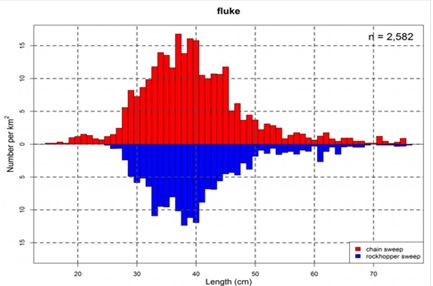
Nils Stolpe – Summer Flounder Management – Can it get any worse?
Summer flounder, also known as fluke, support recreational and commercial fisheries that are among the most important in the mid-Atlantic and southern New England. They have been a mainstay of recreational fishermen either from their own boats or on for-hire vessels, support a large directed commercial fishery, their incidental harvest is important in other fisheries and they are near the top of the list of must-have meals for summer visits to the shore. Hundreds of party and charter boats depend on them for all or for part of their annual incomes, thousands of private boats seek them out every summer, and much of the business bait and tackle shops do every year depends on the fishery. Hundreds of commercial fishing boats target them or take them incidentally in other fisheries.,, The summer flounder stock has gone from having the highest biomass in 50 years to being on the verge of overfishing in the five years between 2011 and 2016. While no one seems to know why the management program hadn’t been working, the SSC did come up with several possibilities. These included “sources of (fishing) mortality that are not fully accounted in the assessment. These could include under-estimation of discards in both the commercial and recreational fisheries and lower estimates of mortality rates applied to the discards than are actually occurring.” Read the full article here 15:27
Nils Stolpe: Marine Monuments – Don’t let your piece of the ocean be next!
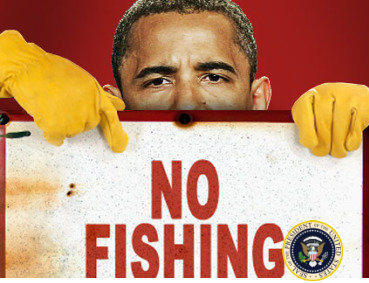 In an effort coordinated by the National Coalition for Fishing Communities (NCFC), thirty four domestic fishing industry trade groups have signed on to a letter to President Obama opposing a strong push by environmental groups and the billion dollar foundations that support them to create marine sanctuaries on both coasts during his last days in office. I don’t need to tell you how much industry effort has been expended over the last several decades to make fishery management under the Magnuson-Stevens Fishery Conservation and Management Act an effective and transparent science-based process. Anyone with an interest in our domestic fisheries, whether on the water, in a shore-based fishing-dependent business or in any way associated with fishing should be committed to improving this process, and President Obama is being urged to circumvent it to bolster his “environmental legacy.” Yesterday the White House announced that the President will be expanding the Papahānaumokuākea Marine National Monument off Hawaii, which was originally created by President Bush in 2006. This will be a no-fishing zone of over half a million square miles. Needless to say, it’s a big hit with the enviros, but it was done without any public process.
In an effort coordinated by the National Coalition for Fishing Communities (NCFC), thirty four domestic fishing industry trade groups have signed on to a letter to President Obama opposing a strong push by environmental groups and the billion dollar foundations that support them to create marine sanctuaries on both coasts during his last days in office. I don’t need to tell you how much industry effort has been expended over the last several decades to make fishery management under the Magnuson-Stevens Fishery Conservation and Management Act an effective and transparent science-based process. Anyone with an interest in our domestic fisheries, whether on the water, in a shore-based fishing-dependent business or in any way associated with fishing should be committed to improving this process, and President Obama is being urged to circumvent it to bolster his “environmental legacy.” Yesterday the White House announced that the President will be expanding the Papahānaumokuākea Marine National Monument off Hawaii, which was originally created by President Bush in 2006. This will be a no-fishing zone of over half a million square miles. Needless to say, it’s a big hit with the enviros, but it was done without any public process.
The letter, with a list of the fishing organizations that are on board so far, is at a web portal set up by the NCFC > Click Here <. Even if you are a member of one of those organizations, please take the few minutes required to personally sign. If you are in a fishing organization that hasn’t, please encourage the leadership to do so. And please encourage as many other folks as possible. The time for top-down governmental dictates was over years ago. We have a system that is starting to work both for the fishermen and the fish and we can’t let it be short circuited. There’s too much at risk.
Nils Stolpe: MPA’s – ENGOs and Foundations next attempt to halt fishing – Déjà vu all over again
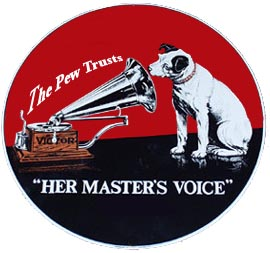 Back in 2002, when various groups and people had figured out that the creation of things called marine protected areas (MPAs) could be sold politically as a mechanism for “saving the oceans,” the people at the Pew Charitable Trusts and the Conservation Law Foundation hired a marketing firm, Edge Research, to demonstrate that New Englanders and Maritime Canadians would be firmly behind using them to put even more fishermen out of work. Well, borrowing from a line made popular by the late Heather O’Rourke in the movie Poltergeist II, they’re back! Only this time they’re trying to convince the Obama White House that two areas off the New England coast are deserving of protection in perpetuity by being designated as National Monuments. Read the rest here 11:36
Back in 2002, when various groups and people had figured out that the creation of things called marine protected areas (MPAs) could be sold politically as a mechanism for “saving the oceans,” the people at the Pew Charitable Trusts and the Conservation Law Foundation hired a marketing firm, Edge Research, to demonstrate that New Englanders and Maritime Canadians would be firmly behind using them to put even more fishermen out of work. Well, borrowing from a line made popular by the late Heather O’Rourke in the movie Poltergeist II, they’re back! Only this time they’re trying to convince the Obama White House that two areas off the New England coast are deserving of protection in perpetuity by being designated as National Monuments. Read the rest here 11:36
Nils Stolpe
ENGOs and Foundations next attempt to halt fishing – Déjà vu all over again
Nils Stolpe, Fishnet USA
Back in 2002, when various groups and people had figured out that the creation of things called marine protected areas (MPAs) could be sold politically as a mechanism for “saving the oceans,” the people at the Pew Charitable Trusts and the Conservation Law Foundation hired a marketing firm, Edge Research, to demonstrate that New Englanders and Maritime Canadians would be firmly behind using them to put even more fishermen out of work. They used what they termed “public opinion polling” to demonstrate this. I devoted a couple of thousand words to a critique on this exercise, and that FishNet is available at http://www.fishingnj.org/netusa21.htm. Replies from Sara Clark Stuart at the Conservation Law Foundation and from Lisa Dropkin at Edge Research (to which I added additional comments) are at http://fishnet-usa.com/AnnotatedDropkinMemo.pdf.
Well, borrowing from a line made popular by the late Heather O’Rourke in the movie Poltergeist II, they’re back! Only this time they’re trying to convince the Obama White House that two areas off the New England coast are deserving of protection in perpetuity by being designated as National Monuments.
Needless to say, their campaign to do this comes with the to be expected major PR campaign, getting as much mileage as possible from what appears to be saturation-level social media manipulation and another Edge Research “strategic marketing survey.”
One of the more clever things in this most recent bout of “market research” was the lumping of mining, drilling and fishing together. This seems to me to be tantamount to asking people how they feel about crimes committed by “murderers, rapists and shop lifters.” After the recent (and very possibly still ongoing) BP disaster in the Gulf of Mexico we all have a pretty accurate idea of what the potential downsides are to drilling in the oceans, and who hasn’t seen pictures of huge open pit mines (if you are one of the few who hasn’t, Google “open pit mine” and click on images)? Not in our ocean, huh?
But can anyone make a rational connection between mining, drilling and fishing? Is there any comparison between the gross negligence practiced by our federal regulators and the offshore oil industry and a fleet of fishing boats working sustainably to provide our consumers with healthful seafood? Can tearing down mountains and creating holes that rival the Grand Canyon be equated with the “damage” done by hooks and nets? Not in the real world, for sure. But in the fantasy ocean world that mega-foundation millions are being spent to create there’s apparently no difference – or the people who have been bought by those foundation’s millions want everyone to believe there isn’t.
In a memo presenting their survey results and their conclusions the people at Edge Research write “while there is currently no drilling and mining in these areas, there is some commercial fishing activity. Protecting these areas would prohibit the fishing activity in these limited areas and could result in a small adverse economic impact on commercial fishing.” It’s axiomatic but it probably doesn’t hurt to state that what is “a small adverse economic impact” to the people at Edge Research, at Pew, at the Conservation Law Foundation or at any of the other involved organizations who can with clear conscience equate the impacts of fishing with the impacts of mining and drilling is unquestionably the difference between staying in business and bankruptcy to dozens of small New England businesses. But the drillers will keep on drilling and the miners will keep on digging, just like always.
Do you want the fisheries that you depend on to be controlled by politically spawned dictates from the White House or by a science-based system that is based on input from you and other stakeholders? Do you want federal fisheries policy to be a result of manipulations by professional pollsters working for anti-fishing ENGOs and the foundations that support them?
This isn’t just a New England problem. This allows any anti-fishing group with enough dollars and enough political clout to ride roughshod over a fisheries management that, while not yet perfect is something that we’ve all invested a tremendous in improving. Below I’ve attached the text of an email from the National Coalition for Fishing Communities addressing this issue as well. New York Congressman Lee Zeldin has prepared legislation that, while not a permanent fix, will put the Foundations/ENGOs plans on ice for a year. This will allow us time to work on a permanent solution. I don’t know this fared last night but regardless of that call your local House Member’s and your Senators’ offices and let them know how important this issue is to you and to your future in fishing.
Nils Stolpe FishNet USA
ACTION ALERT: Contact Your Member of Congress Tonight to Support Zeldin Amendment to Limit Antiquities Act – Click here
Nils Stolpe – Magnuson management – how well is it working?
Nils Stolpe, FishNet USA
“Through investment and sacrifice on the part of our commercial and recreational fishermen, today, landings by U.S. commercial fishermen—and the value they get for those landings—are near all-time highs” The Governance of Fish: Forty Years under the Magnuson-Stevens Act, 04/11/2016, Sam Rauch (Deputy Assistant Administrator for Regulatory Programs, NOAA Fisheries)
Periodically I like to do an overview of U.S. fisheries to give readers the opportunity to evaluate how their fisheries are doing relative to other domestic fisheries. This seems particularly relevant today, particularly considering Sam Rauch’s “happy birthday to us” anniversary statement up above.
Considering that the NOAA/NMFS commercial landings database (http://www.st.nmfs.noaa.gov/st1/commercial/landings/annual_landings.html) lists over 480 fisheries, how to approach this task has always been a challenge. Considering each one would be extremely cumbersome and time consuming and would cover a lot of fisheries that are of interest to only a very small part of the industry. For example, there are 300+ fisheries that had less than $1,000,000 worth of landed value in 2014 and 100+ fisheries with a landed value less than $20,000. This isn’t to imply that these smaller fisheries aren’t important. To the fishermen, other businessmen and consumers who count of them, every fishery is important. But as a practical matter they can’t all be addressed here.
(I have appended a few paragraphs at the end of this FishNet that will walk you through the process for any of the fisheries that NOAA/NMFS monitors).
How are the twenty-five most valuable commercial fisheries doing?
The U.S. commercial fishing fleet landed five and a half billion dollars’ worth of finfish and shellfish in 2014, and about 80% of that – four and a quarter billion dollars’ worth – was landed in the 25 most “valuable” fisheries. In fact, the New England/mid-Atlantic lobster and sea scallop fisheries together landed over a billion dollars’ worth of product.
Thus, to avoid the appearance of “cherry picking” the fisheries to include, I decided that I would look at the top 25 fisheries in terms of landed value. These are divided between finfish and shellfish, are well spread geographically, utilize each of the major gear types, and the vessels that participate range from the smallest to the largest commercially fishing. The 25 fisheries take place in the estuaries and in inshore and offshore waters, and are managed by the states, by the federal government through the regional management councils, by the interjurisdictional Commissions or jointly by the latter two.
I initially choose a twenty-five year time frame – 1990 to 2014 – because it is generally accepted as the length of a human generation and is long enough to even out a lot of the normal highs and lows in annual landings (more on this later). It also avoids the spikes in landings that were associated with what can best be described as post-Magnuson euphoria.
The values reported in the NOAA/NMFS Landings Database are the nominal values (the values of the annual landings in that year’s dollars). Using these values would ignore the effects of inflation, which becomes quite significant over time. As an example, the 40 million pounds of coho salmon landed in 1950 returned only $7 million dollars to the fishermen at the time, yet what that $7 million would buy in 1950 would cost $70 million in 2015. Thus the blue lines represent the value of the landings of the listed species in 2015 dollars, converted using the Consumer Price Index (CPI).
Nils Stolpe – Are you getting the idea that if you’re a fisherman Daniel Pauly isn’t on your side?
 FishNet-USA/February 22, 2016 – “… The crisis in the world’s fisheries is less about scientific proof than about attitude and political will. And the world’s fish need a dynamic, high-profile political champion like a Bono or Mandela to give finned creatures the public profile of cute and furry ones.” (Daniel Pauly in “Hooked on fishing, and we’re heading for the bottom, says scientist”,,, This quote by the Pew Charitable Trusts’ premier fisheries researcher says just about all that needs to be said about the ongoing anti-fishing campaign that they have been financing, along with a handful of other mega-foundations, to convince anyone who is willing to listen that, in spite of a dearth of compelling scientific evidence supporting this strum und drang , the world’s oceans are – and have been – facing a crisis brought about because of the depredations of commercial fishermen. Where are the Kardashian’s when Pauly really needs them? Read the rest here 19:23
FishNet-USA/February 22, 2016 – “… The crisis in the world’s fisheries is less about scientific proof than about attitude and political will. And the world’s fish need a dynamic, high-profile political champion like a Bono or Mandela to give finned creatures the public profile of cute and furry ones.” (Daniel Pauly in “Hooked on fishing, and we’re heading for the bottom, says scientist”,,, This quote by the Pew Charitable Trusts’ premier fisheries researcher says just about all that needs to be said about the ongoing anti-fishing campaign that they have been financing, along with a handful of other mega-foundations, to convince anyone who is willing to listen that, in spite of a dearth of compelling scientific evidence supporting this strum und drang , the world’s oceans are – and have been – facing a crisis brought about because of the depredations of commercial fishermen. Where are the Kardashian’s when Pauly really needs them? Read the rest here 19:23
Nils Stolpe: While it’s called fishery management, it’s not even close – Managing fishing, not fish
“At the global scale, probably the one thing currently having the most impact (on the oceans) is overfishing and destructive fishing gear.” (former National Oceanic and Atmospheric Administration head Jane Lubchenco in an interview on the website Takepart.com on April 7, 2010.) The Deepwater Horizon oil spill catastrophe began on April 20, less than two weeks later. Each year in the U.S. hundreds of millions of tax dollars are spent on what is called fishery management. It’s called fisheries management in the Magnuson-Stevens Fishery Conservation and Management Act. Read the article here 19:14
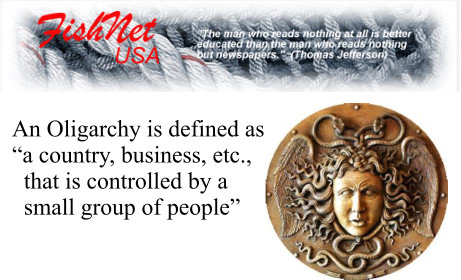
Who’s really in charge of U.S. fisheries? – Nils Stolpe, FishnetUSA
An Oligarchy is defined as “a country, business, etc., that is controlled by a small group of people” – Ancient City Shrimp is an eight minute YouTube video (Click here) produced by the St. Augustine Lighthouse Museum that examines St. Augustine’s past as one of several centers of commercial shrimping in Florida. Unfortunately – or perhaps tragically is a better fit – Florida’s shrimp fleet is only a shadow of what it once was. One of the reasons for this is the imposition of unrealistic regulations on U.S. shrimpers that has made the fishery much less profitable than it used to be. A history lesson or two. Read the rest here 16:27
Who’s really in charge of U.S. fisheries? – Nils Stolpe, FishnetUSA
An Oligarchy is defined as “a country, business, etc., that is controlled by a small group of people”
Ancient City Shrimp is an eight minute YouTube video (Click here) produced by the St. Augustine Lighthouse Museum that examines St. Augustine’s past as one of several centers of commercial shrimping in Florida.
Unfortunately – or perhaps tragically is a better fit – Florida’s shrimp fleet is only a shadow of what it once was. One of the reasons for this is the imposition of unrealistic regulations on U.S. shrimpers that has made the fishery much less profitable than it used to be.
The video’s producers don’t really focus on this as one of the reasons for this decline, rather emphasizing the impacts of cheaper – and generally inferior – shrimp from abroad. This is understandable. You can only cover so much ground in a short video. Opening the can of worms that fishery regulation in the Southeast has become is a guarantee of complication and controversy, things which few museums would willingly get involved in.
In spite of a really good job overall I found part of the final narration troubling. Almost at the end (7 minutes and 50 seconds or so in) the narrator in his wrap-up states “while we can’t change federal regulations we can change our purchasing habits. Demand local shrimp (my emphasis added).” He’s on target with the “demand local shrimp” but it’s hard to imagine anything more antithetical to the principles that our country was founded upon than his acceptance of the idea that we can’t, or that we shouldn’t, change federal regulations.
While it seems unlikely, apparently he missed out on any exposure to or consideration of the words “government of the people, by the people, for the people, shall not perish from the Earth.”
As close to immortal as any words spoken in the last half a millennium, they are from Abraham Lincoln’s Gettysburg Address. In a commemoration of the sacrifices of Union soldiers in the battle of Gettysburg, on November 19, 1863, President Lincoln expressed what governance in the United States was all about. To repeat those words, “government of the people, by the people, for the people.”
It kind of makes you wonder how the documentarians who put together Ancient City Shrimp became convinced that we (the people, I presume, as in the U.S. Citizenry) can’t or shouldn’t change federal regulations. One possibility is that they weren’t aware that Aldous Huxley’s 1984 was a work of fiction. Another would be that they have been exposed to the bottomless morass that federal fisheries management has been turned into.
A history lesson or two
Back in 1976 (this was before the existence of a multi-billion dollar environmental industry so thankfully they weren’t there ti impede the process) the Magnuson-Stevens Act became law. It brought fishing in the U.S. Exclusive Economic Zone under federal control and established a management regime that would eventually phase out virtually all foreign commercial fishing in U.S. waters.
It was generally agreed that one of the strongest features of the Act was the determination that fishermen were an integral part of the federal fishery management process. This was achieved by mandating that fishermen were voting members on each regional Fishery Management Council.
This was in recognition of a number of factors that the public, or at least the majority of the involved politicians and bureaucrats, have subsequently turned – or been turned – away from. Among these were the relative lack of knowledge of our fisheries and what affects them, the value to fisheries managers of the knowledge that has been accumulated by a multigenerational fishing industry over many years, and the belief in and the commitment of fishermen to the long term sustainability of the fisheries they participate in.
Since then a concerted and successful effort has been mounted to reduce the role that fishermen and other fishing industry members play in federal fisheries management. The role that they once had, and that Congress had intended them to have, has been taken over by fishery scientists. Unfortunately science’s understanding of our living marine resources and their all-important relationships with a rapidly and radically changing marine environment has lagged far behind the management authority that scientists have been given. Most simply stated, they are now making multi-million dollar decisions based on woefully inadequate data and the system is bound to this ill-conceived strategy with no recourse when common sense argues compellingly against it.
These changes have been forced by a handful of ENGOs funded by several multi-billion dollar foundations as soon as the public relations, political and financial benefits of “demonizing” fishermen and fishing became apparent to them. This has resulted in many boats being permanently forced off the water, many shore-side support businesses permanently shutting down and a general public impression that most of what’s wrong with our fisheries and our oceans is due to uncontrolled and uncaring fishermen. The ongoing and now institutionalized New England groundfish debacle is a sad example of this. These foundations and the ENGOs and academics that they have hired have also paved the way for a “revolution” in fishing, but not in how fish are caught or provided to consumers, but in how fishing businesses are actually structured.
Recognizing that this has been going on and familiar with the significant negative impacts it has been having on traditional fishermen and traditional fisheries, fishing industry supporters in Congress have been and still are committed to restoring the role of fishermen in federal fisheries management. In spite of a seeming avalanche of what can’t be seen as anything other than anti-fishing propaganda, they are still intent on incorporating all we have learned about maintaining sustainability in the fisheries management process.
Behind the anti-fishing ENGOs
I’ve written before about how fisheries management has been distorted by influence brought to bear by a handful of multi-billion dollar foundations, the PR machines they control and the organizations and individuals that they use their wealth to co-opt. Never before, however, have I come across such a clear cut example of how this is done as I did in the ongoing campaign over the past year striving to stop fishing industry supported amendments to the Magnuson-Stevens Fisheries Conservation and Management Act.
Introduced by Alaska Congressman Don Young, who is now the third most senior Member of the House of Representatives, the legislation was named the Strengthening Fishing Communities and Increasing Flexibility in Fisheries Management Act. In his words it “aims to improve federal fishery management in order to give Regional Fishery Management Councils the proper tools and flexibility necessary to effectively manage their fisheries.” The Congressman, along with Congressman Gerry Studds (D, MA) and Senators Warren Magnuson (D, WA) and Ted Stevens (R, AK) played a key role in originally creating the Magnuson-Stevens Act and getting it passed. (While it’s not mentioned on Congressman Young’s website at http://donyoung.house.gov/news/documentsingle.aspx?DocumentID=398236, the problems in the current version of the Act are those that are there thanks to aggressive and expensive campaigns by a handful of foundation funded ENGOs to amend the original Act.)
The Pew Charitable Trusts and individuals and organizations they support have been in large part responsible for this campaign, as they were for the initial amendments that Congressman Young’s legislation is attempting to put right.
Back in May I was forwarded an email from a government and business consulting firm with offices in Washington, DC, Newark, NJ, Trenton, NJ, Albany, NY, Columbus, OH, and Harrisburg, Philadelphia and Pittsburgh, PA. The email was a follow-up to a previous message and the subject was “FISH-Executive Chef Sign on Letter.”
The author wrote that she was working with the PEW Charitable Trusts to get signatures on a letter asking Members of Congress to, among other things, “oppose efforts to weaken the conservation provisions of the law….” The law is the Magnuson-Stevens Act. The efforts to “weaken it” are the Strengthening Fishing Communities and Increasing Flexibility in Fisheries Management Act. A careful reading of the proposed amendments to the Act would show that this is in no way accurate.
The letter was an attempt to get executive chefs from the food industry, a group which has become increasingly powerful in molding political opinion and public policy since the advent of “celebrity chefs,” to “protect” fish and shellfish in U.S. waters from the supposed depredations of supposed anti-conservation minded U.S. fishermen
This appeal resulted in a letter addressed to Members of Congressed dated May 29 that was posted on Congressman Grijalva’s House Natural Resources Committee minority website. It cited the opposition of the signatories (executive chefs and others) to the efforts to amend Magnuson; amendments that would once again allow fishermen more of a say in fisheries management and give fisheries managers some flexibility when the existing science isn’t adequate to support what are now government mandated management actions. The letter is at http://tinyurl.com/GrijalvaSiteLetter . It was identified as “Chefs Letters Opposing Empty Oceans Act.”
Congressman Grijalva is the ranking member of the House Resources Committee.
(The U.S. Bureau of Labor Statistics estimates that there were 118,000 chefs and head cooks employed in the U.S. in May of 2014. Statista reported the number of restaurants at over 600,000. The letter was signed by 37 chefs.)
Cited along with this were letters from 18 other groups. One was from the Pew Charitable Trusts. The other groups have directly or indirectly received tens of millions of dollars from those “Charitable” trusts. Among them was one from the group identified as the “NGO Community,” signed by representatives of The Conservation Law Foundation (received at least $1 million from Pew), Earthjustice (received at least $23 million from Pew), Gulf Restoration Network (received almost $1 million from Pew), Oceana (received at least $62 million from Pew), Chesapeake Bay Foundation (received $1/4 million from Pew), Environmental Defense (received at least $2 million from Pew), Ocean Conservancy (received at least $1/2 million from Pew), Natural Resources Defense Council (received at least $1 million from Pew). A letter identified as from the Fishing Community Coalition was signed by the President of The Cape Cod Commercial Fishermen’s Alliance (received at least $1.5 million from Pew while previously known as the Cape Cod Commercial Hook Fishermen’s Association). The New England Aquarium (received at least $11 million from Pew) and The Marine Fish Conservation Network (received at least $4 million from Pew) sent their own letters.
Fine, you might say, particularly if you’ve swallowed all of the anti-fishing propaganda directly or indirectly paid for by a small group of huge foundations. Making them especially effective at this, they have pooled their efforts to “revolutionize” fishing (see the addendum about U.S. Agency for International Development creation, the Consultative Group on Biological Diversity), or rather to revolutionize fishing businesses, in our federal waters.
For a bit more insight as to what’s going on let’s follow some of the money.
The Pew Charitable Trusts were established by the heirs of the founder of Sun Oil (Sunoco). While estimates vary, it seems to be generally accepted that the Trusts have in the neighborhood of $5,000,000,000 in assets (for an idea of scale, the entire U.S. commercial fishing industry lands about five billion dollars’ worth of fish and shellfish each year).
The Pew Trusts are controlled by a Board of Directors. Seven of the Board members are Pews, another, Rebecca Rimel, is the Executive Director of the Trusts. Another, Robert H. Cambpell, “…served as Chief Executive Officer of Sunoco Inc., a domestic refiner and marketer of petroleum products from September 1991 to June 2000 and its President from 1991 to 1996.” Another, Susan W. Catherwood, is “a Director of The Glenmede Corporation. She is also a Director at The Glenmede Trust Company, N.A. since 1998. She is also a Director of the Glenmede Trust Company of New Jersey…. She serves as a Trustee at The Glenmede Fund, Inc.” (from Company Overview of The Glenmede Corporation, Bloomburg Business). Another, Aristides W. Georgantas, is on the Board of Glenmede. Another, Robert G. Williams is Chairman of The Glenmede Corporation and Director of The Glenmede Trust Company, N.A.
And “the Glenmede Trust Company was founded in Philadelphia, Pennsylvania in 1956 by four children of Joseph N. Pew, founder of Sun Oil Company, to serve as the corporate trustee for the trust they had endowed to honor their parents. The Pew Memorial Trust, as it came to be known, was funded with Sun Oil Co. stock…” (https://www.glenmede.com/our_story/history).
It seems inarguable that the Board of the Pew Trusts, with at least twelve members (out of thirteen) having close ties to the Sun Oil fortune and/or its offspring, the Glenmede Trust Company, wanted Congressman Young’s proposed fisherman friendly amendments to the Magnuson-Stevens Act to be defeated. These amendments would have instituted some conservation neutral “fixes” to Magnuson provisions which had been added since 1976 and which have been threatening the continued existence of fishermen, fishing families, fishing businesses and fishing communities around our coasts. But with the resources of a huge and powerful organization to draw on, it’s pretty easy to get what you want.
If this was an important issue for regular folks – meaning those of us of limited means who either aren’t very, very wealthy or don’t work for or hang out with those who are – we might call the offices of our reps in Congress. If it were a really important issue we might write them a letter or two. If it were a potentially life-shattering issue we might visit their local or DC offices.
Along with voting every couple of years and staying politically informed I’m pretty sure that’s the kind of thing that Lincoln had in mind with his of, by and for the people.
What did the people at Pew do? They spent some of their five billion or so dollars – they used to report relevant information about their grants (amount, for what, to whom) on their website but they stopped that several years back so we don’t know how much they spent – to hire at least one consulting firm. And the consulting firm set out to get a bunch of chefs to sign on to a letter that while seeming to save these fishermen – and the fish in the EEZ – from their own greed and shortsightedness would in fact continue the campaign of regulating them out of business.
This letter was accompanied by other letters from people and organizations – mostly ENGOs – that had either benefitted from Pew funding that ranged from hundreds of thousands to tens of millions of dollars or that were apparently convinced by other means (more consultants?) to sign on.
How much did all of those other letters cost?
Some obvious questions stemming from these manipulations concern what the total cost was to Pew, how actually informed were the signatories that Pew or Pew’s grantees or Pew’s hirelings on the issues that their letters addressed, and how representative of government of, for and by the people is this?
Is there an oligarchy in fishing’s future?
For the past several years, fanned by what’s going on in modern Russia, there has been a lot of interest by the media in oligarchs and oligarchies. Defined as “a country, business, etc., that is controlled by a small group of people” (Merriam-Webster Online Dictionary), an oligarchy would seem to be the antithesis of government as Lincoln envisioned it. But along with the foregoing, follow some of the links below and then consider the influence Pew has in or over the domestic fisheries management system (and on fisheries management in other countries as well). And consider as well that thirteen people wield all that power. Of those thirteen people seven are in the founder’s family and at least twelve have significant ties to Sun Oil/Sunoco and/or the private bank that was formed to administer the trusts established with Sun Oil/Sunoco stock. You decide!
To the extent that multi-billion dollar foundations such as Pew continue to have their way by mounting campaigns that any of the affected groups can’t afford to effectively counter, and by exerting influence in Washington that few in the private sector are capable of, the folks at the St. Augustine Lighthouse Museum who think the people can’t change government will be justified. And the rest of us, those of us who know that Lincoln had it right at Gettysburg, will be increasingly marginalized.
________________________________________________
To put the potential impact of Pew’s billions of dollars into a more comprehensible context, follow the links below:
- Pew, Academia and ENGOs – For a listing of projects funded by the Pew Trusts and several other multi-billion dollar foundations intending to fix (in their view) fishing and ocean governance look at the foundations grants database on the http://www.fishtruth.net website – on the “Connections” page follow the link at the beginning of the third paragraph. Grants were only listed until 2008. After that date the foundation folks made it much less convenient to determine who they were paying for what. From 1998 to 2008 Pew provided over $270 million to Universities, ENGOs and fishermen’s Associations for fisheries and related projects.
- Pew, USAID and other Foundations – The question of the degree of coordination and cooperation between and among the involved foundations has often arisen. Not too surprisingly, the federal government through the USAID has been fostering such coordination and cooperation through its low profile Consultative Group on Biological Diversity. See a column I wrote for Saving Seafood at http://www.fishnet-usa.com/All%20Stolpe%20Columns.htm#CGBD for some background.
- Pew and federal fisheries governance – Pew, Much of the existing federal oceans policy was determined by the Pew Oceans Commission (and its doppelganger, The United States Commission on Ocean Policy) which issued its final report in 2003. In The Pew Commission – a basis for national ocean policy? ( http://www.fishingnj.org/netusa23.htm) I discuss some of the shortcomings of the Pew Commission and its “accomplishments.”
- Pew and the media – At least until 2008 Pew’s financial support of print and broadcast media was of the same magnitude (or greater) than its support of reconfiguring fisheries management/ocean governance. A synopsis of Pew and the media pre 2008 is available on the FishTruth website at http://www.fishtruth.net/PDF/PewMedia.pdf.
- On a more personal level see In the Belly of the Big Green Beast at http://www.fishnet-usa.com/In_Belly_Of_Beast.pdf.
- Pew and Fishermen – For a short analysis of Pew’s efforts in fisheries/ocean governance from an industry perspective see The anti-fishing movement; a U.S. perspective at http://fishtruth.net/PDF/Num1_Antis_Updated.pdf.
- Pew, Congress and the Magnuson Act – In spite of the opposition, Congressman Young’s amendments to Magnuson embodied in the Strengthening Fishing Communities and Increasing Flexibility in Fisheries Management Act passed the House of Representatives and went to the Senate. There has been no subsequent action and President Obama has indicated an unwillingness to sign it if it passes in the Senate.
- Pew and the Obama Whitehouse – At the very beginning of President Obama’s first term his administration organized the Setting Ocean Priorities for the New Administration and Congress Workshop. There were 65 participants and 13 staff listed. Of them over 75% had identifiable ties to funding from either Pew or three other mega-foundations who have been active in fisheries-related funding from about the same perspective as Pew but to a lesser extent. Of the five “fishermen” participants, one who was recreational and four commercial, all have ties to at least one of the foundations. The participants and staff and their connections are listed at http://www.fishtruth.net/ObamaAdminWorkshop.htm.
- Pew and astroturf roots – The people at Pew are past masters at making campaigns that they originate and in large part operate appear as if they are actually “grass roots” movements. I examined this phenomena in Your roots are showing (http://fishnet-usa.com/RootsAreShowing.pdf)
- The times they are a’changin for the Saving Seafood website
- http://www.savingseafood.org/opinion/the-times-they-are-a-changin-by-nils-stolpe.
Nils Stolpe: Atlantic herring – lots of smoke but where’s the fire? – Click Here
Peter Shelley is a lawyer who works for the Conservation Law Foundation (CLF). Apparently among his duties is providing entries to the CLF website “Talking Fish.”
For those of you who aren’t familiar with the groundfish debacle in New England, Mr. Shelley and the CLF, utilizing the court system and a whole bunch of money (according to their IRS Form 990 filed in 2011- the last year available on the Guidestar website – total CLF revenue was $5,800,000, up $1,250,000 from the year before), have been playing a pivotal role in the groundfish fishery management program via the management process and the courts since before it was a debacle. Evidently the groundfish fishery wasn’t enough to fill Mr. Shelley’s plate so he has been involved in Atlantic (sea) herring management as well. Read more here 14:34
NILS STOLPE: Of gumballs, the American Sportfishing Association and fisheries management
FishNet USA — May 9, 2014 — To equate what a recreational fisherman pays to catch a fish to what a commercial fisherman is paid to catch that same fish is to equate the total cost an equestrian pays to ride her horse for a mile to what Amtrak would charge to move her the same distance on a train. The people at the American Sportfishing Association (ASA) are embarking on the second year of a campaign to convince anyone who will listen that recreational fishing is equally as or more important than commercial fishing and that in their estimation the federal government should not be putting so much emphasis on managing the commercial fisheries. Read more here 19:27
NILS STOLPE: Of gumballs, the American Sportfishing Association and fisheries management
FishNet USA — May 9, 2014 — To equate what a recreational fisherman pays to catch a fish to what a commercial fisherman is paid to catch that same fish is to equate the total cost an equestrian pays to ride her horse for a mile to what Amtrak would charge to move her the same distance on a train.
In the press release Nussman stated “the current federal saltwater fisheries management system has historically focused the vast majority of its resources on the commercial sector, when recreational fishing is found to have just as significant an economic impact on jobs and the nation’s economy.”
You might ask what the point of this exercise is.
According to Nussman “we’re not releasing this report in an effort to demean commercial fishing. Commercial fishing is very important to our nation’s economy! Our goal is to highlight the importance of recreational fishing to the nation. As our coastal populations continue to grow, along with saltwater recreational fishing, significant improvements must be made to shape the nation’s federal fisheries system in a way that recognizes and responds to the needs of the recreational fishing community.”
Among other things, “demean” means to lower in standing, and in spite of Nussman’s assurances to the contrary, it sure seems like that’s exactly what the ASA and their Southwick Associates report is attempting to do.
From the report:
“In 2011 anglers landed 204.9 million pounds of saltwater fish. In pursuit of these fish, saltwater anglers spent $26.8 billion on fishing tackle and equipment and trip-related goods and services. Including multiplier effects, their spending generated $70.3 billion in economic output (sales), created $32.5 billion in value-added growth and supported 454,542 jobs with $20.5 billion in income…. Of the commercial sector’s landings, 4.9 billion finfish pounds were the same species frequently targeted by anglers, with a landed value of $2.1 billion. Including multiplier effects along the entire value chain from harvesters to processors to final consumers, commercial finfish harvest of species also sought by anglers generated $20.5 billion of economic output. This is the “sales impact,” which is not to be confused with expenditures or retail sales which created $10.6 billion in value-added impacts and generated 304,611 jobs with $7.5 billion of income.”
If that isn’t an attempt to lower the standing of commercial fishing, particularly when Nussman introduced the report with the words “the current federal saltwater fisheries management system has historically focused the vast majority of its resources on the commercial sector,” it’s hard to imagine what would be.
The entire report centers around the idea that expenditures on recreational fishing services, equipment and supplies are somehow equivalent – on a dollar to dollar basis – to dollars generated by commercially caught and landed finfish (The Southwick people disregard commercial shellfish landings, which will be discussed below).
In reality commercial fishermen and the people in every other business in the seafood supply chain are dedicated to producing the best possible product at the lowest possible price, as are any business owners engaged in producing products in a free market system. If they weren’t they wouldn’t be in business for very long, because there is a world’s worth of alternative center of the plate proteins competing for the US consumers’ dollars. On the other hand recreational fishermen aren’t buying fish when they go fishing, they are buying a recreational fishing experience, and the more pleasurable that experience is the more they are likely to spend. Within limits this isn’t determined by the amount of fish caught. Recreational fishermen aren’t driven by anything approaching the bottom-line constraints that commercial fishermen and others in the seafood supply chain face.
To equate what a recreational fisherman pays to catch a fish to what a commercial fisherman is paid to catch that same fish is to equate the total cost an equestrian pays to ride her horse for a mile to what Amtrak would charge to move her the same distance on a train. Apples and oranges doesn’t come close to describing how unapt the Southwick comparison is, maybe Ferraris and oranges does.
Why omit shellfish?
In the Southwick report the authors also ignore the value and the economic contributions of the commercial shellfish fisheries (mollusks and crustaceans), stating as their rationale “shellfish are rarely targeted by anglers.” This implies that there is no relationship between commercial shellfish fisheries and commercial or recreational finfish fisheries. The impact that the yellowtail flounder fisheries have on the New England/Mid-Atlantic sea scallop fishery, the most valuable commercial fishery in the US, demonstrates how a seemingly unrelated fishery can have a profound effect on another, and how “dismissing” any of our fisheries, recreational or commercial, can leave naïve readers with severely distorted impressions.
The New England/Mid-Atlantic sea scallop fishery is constrained more by the catch of yellowtail flounder, which supports a small recreational fishery in New England, than it is by sea scallop abundance. If the small allocation of yellowtail flounder is inadvertently exceeded by the sea scallop fleet the sea scallop fishery will be closed for a predetermined period in the subsequent fishing year depending on the amount by which the allocation is exceeded. The allocation of yellowtail flounder to the scallop fleet has been on the order of 500 metric tons annually. The sea scallop fishery, the most valuable commercial fishery in the US with landings that have averaged over a half a billion dollars a year in recent years, is dependent on catching just over a million dollars’ worth of these flounder (that have an ex-vessel value of around a dollar a pound). If the yellowtail flounder population declines for any reason the allocation of them to the sea scallop fishery will be reduced proportionally, as will the sea scallop catch.
The Gulf of Mexico/South Atlantic shrimp fisheries provide another example of how closely intertwined commercial shellfish fisheries and commercial/recreational finfish fisheries are. Domestic shrimp fishermen exert a tremendous effort – at a tremendous expense – to avoid bycatch of juvenile stages of important finfish species, particularly snapper and grouper. The Mid-Atlantic/New England squid fishery is managed in large part for the butterfish bycatch (more on butterfish later). And there are similar finfish interactions in other shellfish fisheries.
Also, and it’s kind of surprising that the Southwick people ignored this, a small yet significant part of the “commercial” shellfish harvest goes to providing bait to recreational anglers, and the price that they pay for their clams, shrimp, squid and clams tend to be quite a bit higher than what consumers are willing to pay for the same products at the seafood counter.
In ignoring the value of the commercial shellfish fisheries the report makes it appear as if fish caught by recreational fishermen add three times as much value to the economy as fish caught by commercial fishermen. The inclusion of all commercially caught fish and shellfish would definitely affect this ratio, meaningless as it is. In fact, well over half of the commercial finfish catch is composed of relatively low value per pound species and virtually all of the commercially caught shellfish are high value per pound. In 2012 the ten most valuable commercial finfish species had an average landed value of less than 26 cents per pound while the ten most valuable shellfish species had an average landed value of over two dollars per pound.
Fishery: SCALLOP, SEA
Landings (MT): 25798.30
Landings (lbs): 56874880.00
Value ($s): 558809255.00
$s/lb: 9.83
Fishery: LOBSTER, AMERICAN
Landings (MT): 67831.90
Landings (lbs): 149542284.00
Value ($s): 429269331.00
$s/lb: 2.87
Fishery: POLLOCK, WALLEYE
Landings (MT): 1302815.40
Landings (lbs): 2872186903.00
Value ($s): 343311377.00
$s/lb: 0.12
Fishery: SHRIMP, WHITE
Landings (MT): 53683.50
Landings (lbs): 118350634.00
Value ($s): 234435088.00
$s/lb: 1.98
Fishery: SALMON, SOCKEYE
Landings (MT): 96542.50
Landings (lbs): 212837690.00
Value ($s): 209934238.00
$s/lb: 0.99
Fishery: SHRIMP, BROWN
Landings (MT): 49637.60
Landings (lbs): 109431019.00
Value ($s): 197883631.00
$s/lb: 1.81
Fishery: COD, PACIFIC
Landings (MT): 325737.90
Landings (lbs): 718121778.00
Value ($s): 186595472.00
$s/lb: 0.26
Fishery: CRAB, BLUE
Landings (MT): 81209.10
Landings (lbs): 179033583.00
Value ($s): 183527265.00
$s/lb: 1.03
Fishery: CRAB, DUNGENESS
Landings (MT): 24303.20
Landings (lbs): 53578848.00
Value ($s): 180671629.00
$s/lb: 3.37
Fishery: CRAB, SNOW
Landings (MT): 40018.90
Landings (lbs): 88225773.00
Value ($s): 166807600.00
$s/lb: 1.89
Fishery: HALIBUT, PACIFIC
Landings (MT): 15382.40
Landings (lbs): 33912005.00
Value ($s): 151887093.00
$s/lb: 4.48
Fishery: SABLEFISH
Landings (MT): 18733.60
Landings (lbs): 41300008.00
Value ($s): 140746491.00
$s/lb: 3.41
Fishery: MENHADEN
Landings (MT): 639754.30
Landings (lbs): 1410402326.00
Value ($s): 107747893.00
$s/lb: 0.08
Fishery: OYSTER, EASTERN
Landings (MT): 10825.90
Landings (lbs): 23866753.00
Value ($s): 104600262.00
$s/lb: 4.38
Fishery: SALMON, CHUM
Landings (MT): 68015.30
Landings (lbs): 149946474.00
Value ($s): 101260007.00
$s/lb: 0.68
Fishery: SALMON, PINK
Landings (MT): 106734.00
Landings (lbs): 235305761.00
Value ($s): 101164489.00
$s/lb: 0.43
Fishery: CRAB, KING
Landings (MT): 7419.90
Landings (lbs): 16357952.00
Value ($s): 90789682.00
$s/lb: 5.55
Fishery: TUNA, BIGEYE
Landings (MT): 6908.80
Landings (lbs): 15231239.00
Value ($s): 70680823.00
$s/lb: 4.64
Fishery: SQUID, CALIFORNIA MARKET
Landings (MT): 97460.50
Landings (lbs): 214861518.00
Value ($s): 63883456.00
$s/lb: 0.30
Fishery: CLAM, PACIFIC GEODUCK
Landings (MT): 1116.60
Landings (lbs): 2461568.00
Value ($s): 54451870.00
$s/lb: 22.12
No matter what the reasoning, not considering the entire commercial fishery relative to the entire recreational fishery leaves readers with an incomplete and very possibly distorted picture.
What about exceeded quotas?
In every discussion about inequities in recreational fisheries management this seems to be the 800 pound gorilla lurking invisibly in the corner.
If you are at all familiar with the current state of fisheries management in the US you know that it’s next to impossible for commercial fishermen to overfish their quota (or TAC or whatever it’s called) in federal waters. Unfortunately that’s not the case with recreational fishermen in recreational fisheries or in those that they share with their commercial colleagues.
At this point virtually every commercial fishery that takes place in federal waters is under one form of limited entry or another. What this means is that you need a federal permit to participate in those fisheries. The number of permits allowed in each fishery is limited. Accordingly it takes more than a boat and a desire to participate in a particular fishery to fish. The controls on the limited number of commercial fishermen in a particular fishery can (and usually do) limit where they can fish, when they can fish, how they can fish, the size and horsepower of their boat, the type and amount of gear they can use and the size and amount of the fish they can catch. Depending on the fishery, when a predetermined amount of a particular species is caught the fishery may be shut down. If the amount caught exceeds the commercial quota, as with yellowtail flounder in the sea scallop fishery, the excess amount may be deducted from the following year’s quota.
Recreational fishermen are managed with various combinations of size, season and bag limits (the number of a particular species of fish that they can have in possession). However, there is no limit to the number of fishermen who can participate in a recreational fishery, nor in how many trips they may make in which they catch a particular species. It seems obvious that a fisheries management system that for all intents and purposes has no cap on the number of participants nor on the number of fish of a particular species each of those participants can take can be pretty far from effective. Recognizing this and effectively dealing with it is one of the improvements that is definitely necessary to, in Mr. Nussman’s words, “reshape the nation’s federal fisheries system.”
As the chart below (from NOAA/NMFS) shows, the number of saltw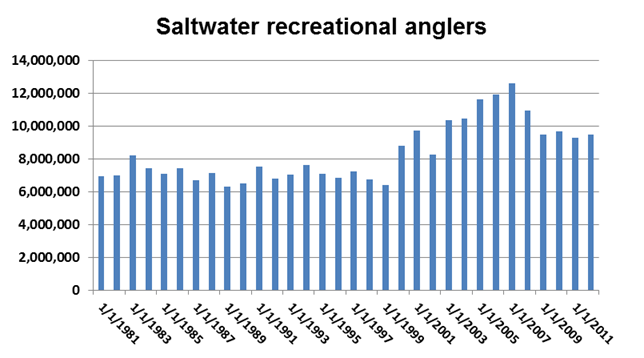 ater recreational anglers, which remained reasonably stable for the last two decades of the twentieth century, grew significantly in most of the first decade of the twenty-first, until the “Great Recession” began. Whether most of those who left come back to the sport or not, there are and will continue to be millions more than there were a decade ago while the productive capacity of our waters isn’t going to increase significantly.
ater recreational anglers, which remained reasonably stable for the last two decades of the twentieth century, grew significantly in most of the first decade of the twenty-first, until the “Great Recession” began. Whether most of those who left come back to the sport or not, there are and will continue to be millions more than there were a decade ago while the productive capacity of our waters isn’t going to increase significantly.
What of what seems to be an underlying theme of Mr. Nussman’s remarks in the press release and in his gumball presentation; the idea that the commercial fisheries are making off with most of the fish and that’s costing the US economy billions of dollars? Coincidentally NOAA/NMFS in the 2012 edition of Fisheries of the United States included a graph titled Top Ten Recreational Species-Harvest Vs. Commercial Harvest reproduced below.
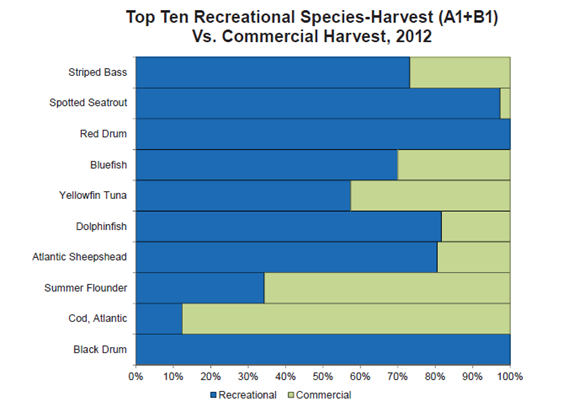
With the exception of Atlantic cod and summer flounder, well over half of the harvest of each of the most recreationally sought species nationally are taken by recreational anglers (I’ll note here that the commercial Atlantic cod fishery was historically our most significant commercial fishery since well before the founding of the United States and the summer flounder fishery has been one of the most important commercial fisheries in the Mid-Atlantic for most of the last hundred years).
Could it be that Mr. Nussman wants even more of these and other species to meet what from a management perspective appears to be the uncontrollable demands (by managing what an angler can catch per trip but not the number of anglers/number of trips) of the recreational anglers? The commercial landings of these ten species and any others that support both recreational and commercial fisheries seem meager indeed, particularly when one considers commercial landings in the US in their entirety. But they certainly aren’t to the fishermen, recreational, party/charter and commercial, who catch them and the businesses they support. And, while Mr. Nussman lumped all commercial finfish fishermen and fisheries together, that is certainly not the real world case. The most valuable commercial fisheries generally involve large companies, big boats, a lot of onshore or onboard processing and a lot of capital. The smaller ones generally don’t, and in them are the fishermen who would suffer the greatest harm from any reallocation. They are also the fishermen who have been the bedrock of our fishing communities from Maine to Alaska and beyond, and as we’re already seeing, as we lose them we lose those communities as well.
The final chart, again from NOAA/NMFS, shows how the number of fish taken home by saltwater anglers each year has declined to less than half of what it was in the 1980s. While I’m in no way expert on the saltwater recreational angling industry, this seems to be a pretty unsustainable trend, but does its continuation have to be inevitable? No more inevitable than the constant whittling down of commercial and recreational quotas are.
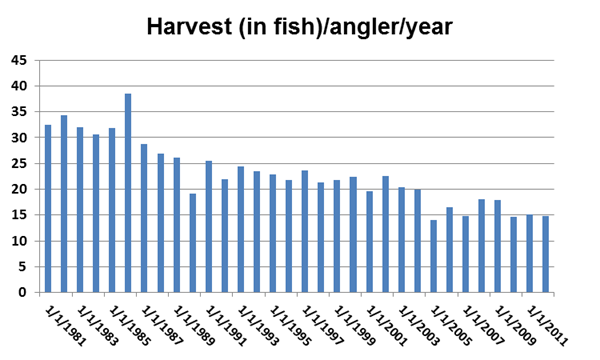
Is there a solution to what I’ll call the saltwater recreational anglers’ dilemma?
Every year more commercial fishermen and the people in fishing dependent businesses are realizing that better science almost always means more fish – and when it doesn’t we definitely don’t want to be catching too many. As long as the precautionary principle is applied only to protect the fish and not to protect fishing communities and is rigidly controlling fisheries management decisions, what we don’t know about fish stocks is going to hurt us. Some of us have come to terms with this and are committing to collaboration with researchers ashore and on the water. One of the most recent positive results of this was announced by the Mid-Atlantic Council last week, reporting that a just completed stock assessment determined that butterfish were presently not overfished and hadn’t been for at least twenty-three years. This assessment was the result of several years of cooperation and collaboration between the Council staff, researchers at the Northeast Fisheries Science Center and several universities, fishermen and their representatives. It wasn’t easy, but it’s getting easier, and the reward is going to be larger – but sustainable – harvests of both butterfish and squid. And it didn’t involve any fishermen trying to grab quota from any other fisherman. All it involved was getting the science closer to right.
A recent NOAA/NMFS publication (Fish Assessment Report – Fiscal Year 2014 Quarter 2 Update available here) reported that only 59.6% of the fish stocks listed on that agency’s Fish Stock Sustainability index had “adequate” assessments (from NOAA/NMFS “generally a minimally adequate assessment can be conducted where there is good information on the level of annual catch and an indicator of the degree of change in stock abundance over time”). Over 40% of our important fish stocks do not. What that means is that, because of the precautionary principle the harvest of almost half of our important fish stocks are too low because we don’t know enough about them because the science isn’t there to adequately assess them.
There’s definitely a message in there for Mr. Nussman and his members. And it wouldn’t require gumballs to illustrate it.
I would be remiss if I didn’t finish this with a reminder that we are importing on the order of 90% of the seafood we consume in the U.S. and fresh, locally produced fish is getting harder and harder to find and increasingly expensive. There are more fish out there. We need to find or force the funding to provide our scientists and our managers with the science necessary to adequately manage our fisheries. That would be good for everyone, not just the recreational fishermen, the commercial fishermen or the party/charter fishermen.
Magnuson not a weapon to use against fishing communities! Nils Stolpe/April 2014
I wrote the column below over six years ago. Since then we have gone through two demonstrations in Washington, DC that were enthusiastically supported by recreational, party/charter and commercial fishermen. Thousands of fishermen finally realized that,,,fisheries.org Read more here 17:51
A must read blog (along with Fishosophy, of course!) Recommended by Nils Stolpe
The blogger is Jonathan Gonzalez, a graphic designer with a solid and obvious commitment to ocean conservation. What separates him from the crowd, and what brought his blog to my attention, was his unwillingness to accept at face value the myriad of commonly held “truths” of marine conservation and his willingness to devote himself to researching what’s really going on in our oceans and in our fisheries. Five minutes invested in reading the “about me” page on his website, Read [email protected] 17:06
Fishosophy: Overfished or Depleted? By Nils Stolpe
 “What’s in a name? That which we call a rose by any other name would smell as sweet.” (William Shakespeare, Romeo and Juliet, Act II, Scene II) Contrary to what might have been true when Shakespeare had Juliet speak those words in the 1590s, how things are called is far from meaningless Read more@fishosophy 22:15
“What’s in a name? That which we call a rose by any other name would smell as sweet.” (William Shakespeare, Romeo and Juliet, Act II, Scene II) Contrary to what might have been true when Shakespeare had Juliet speak those words in the 1590s, how things are called is far from meaningless Read more@fishosophy 22:15






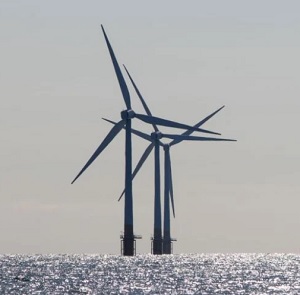




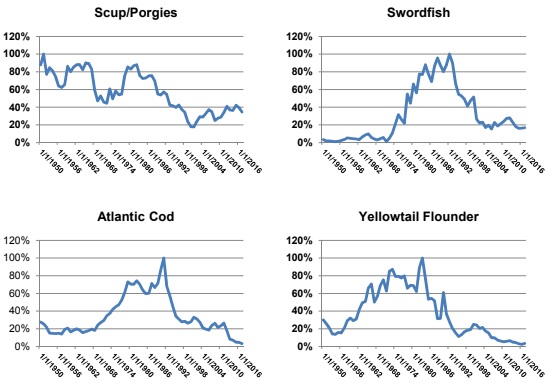
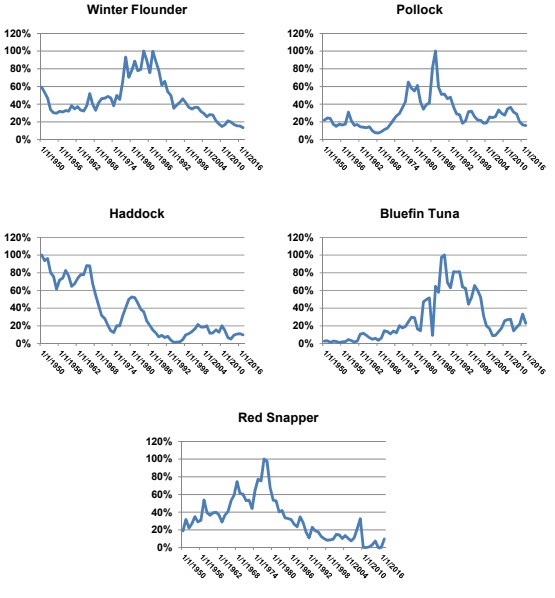
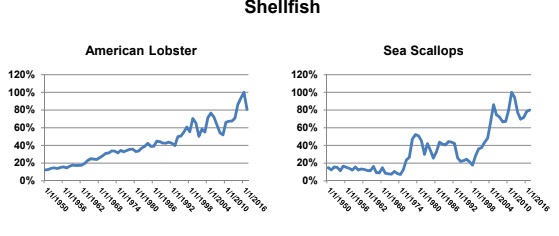

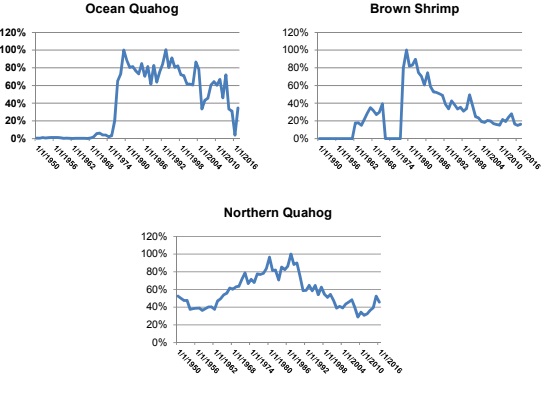


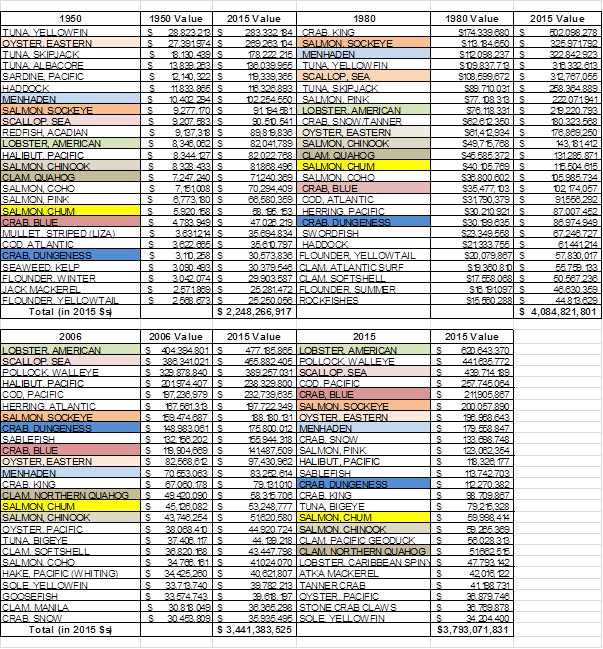
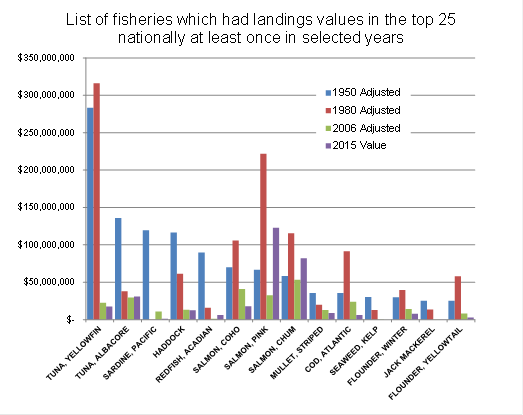
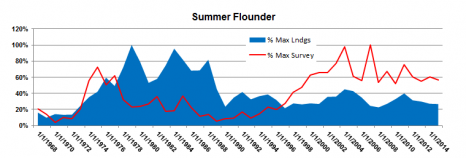

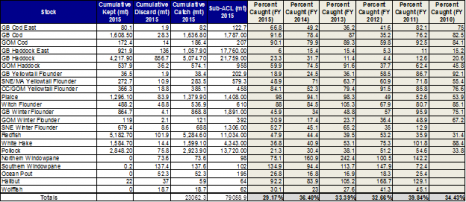
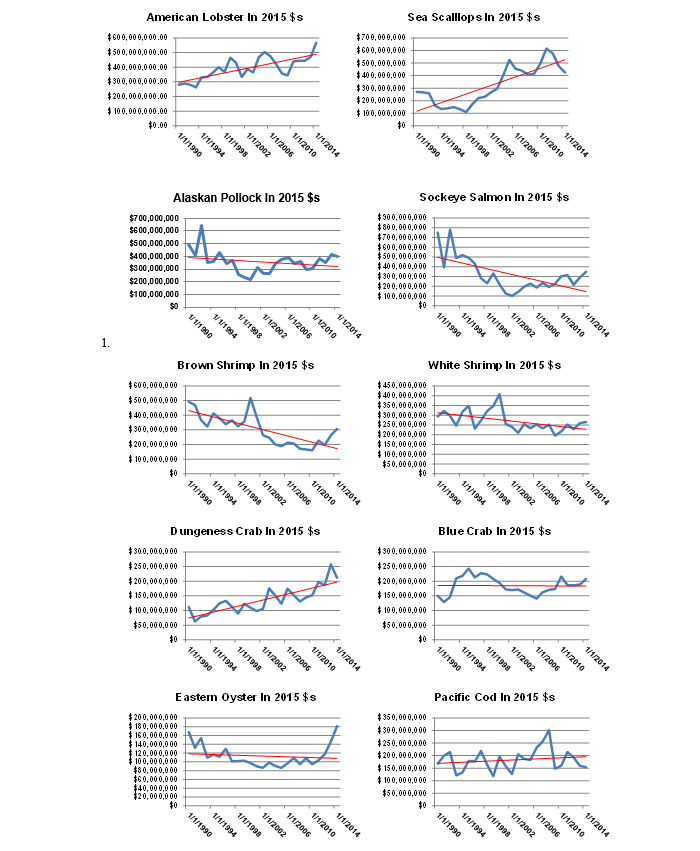
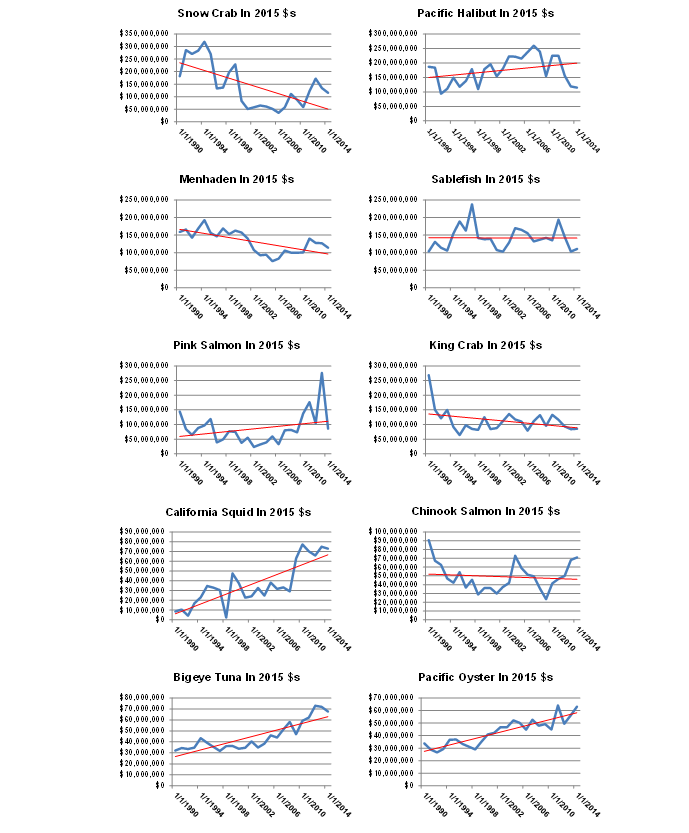
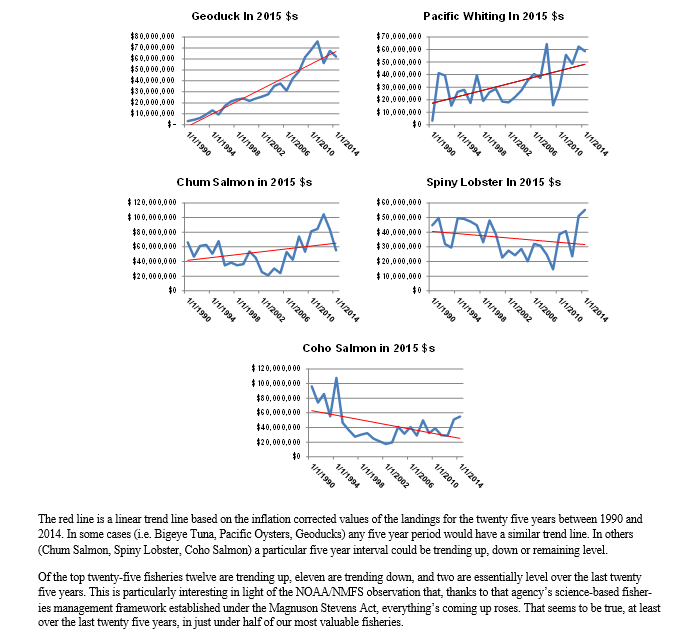
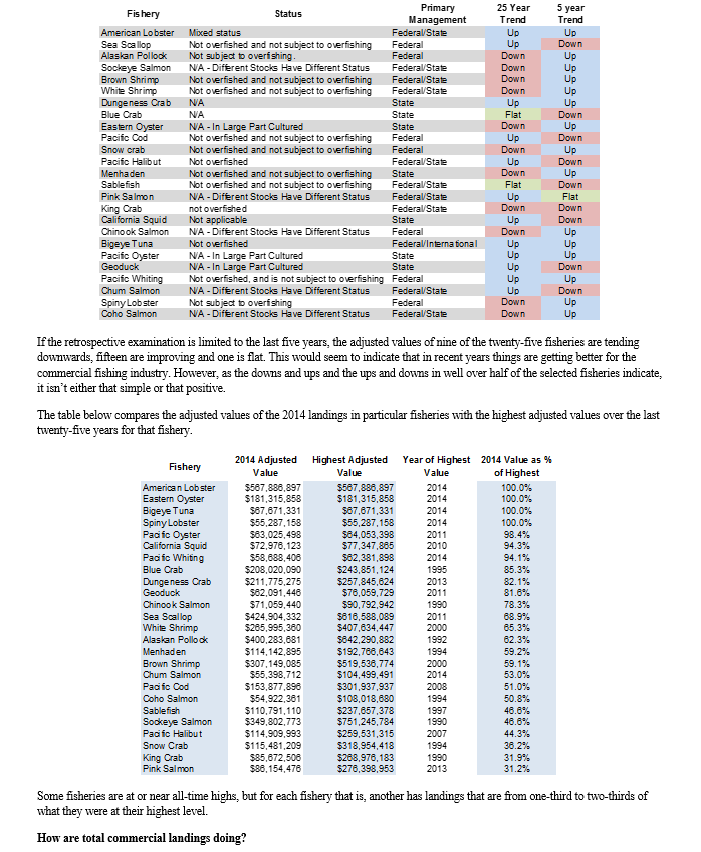
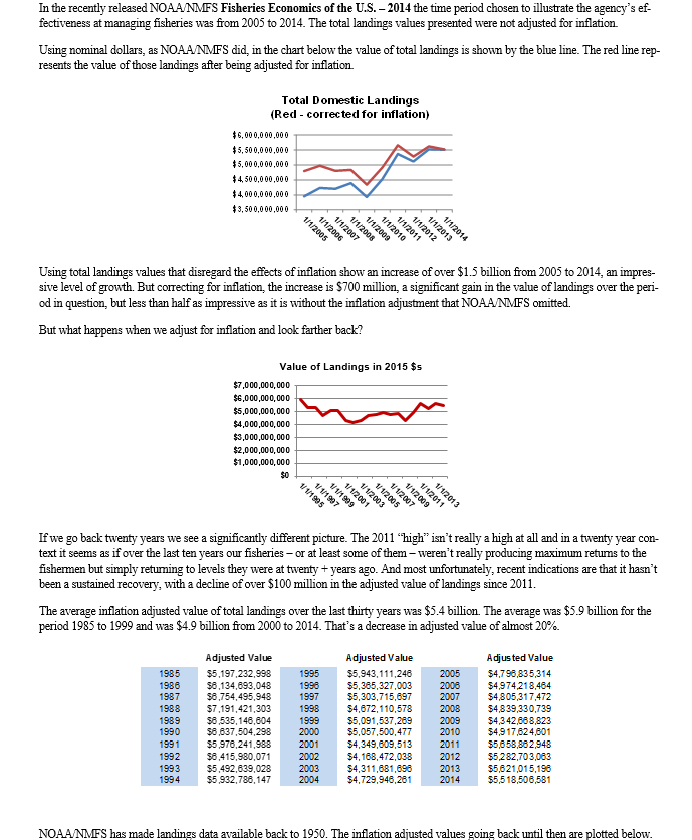
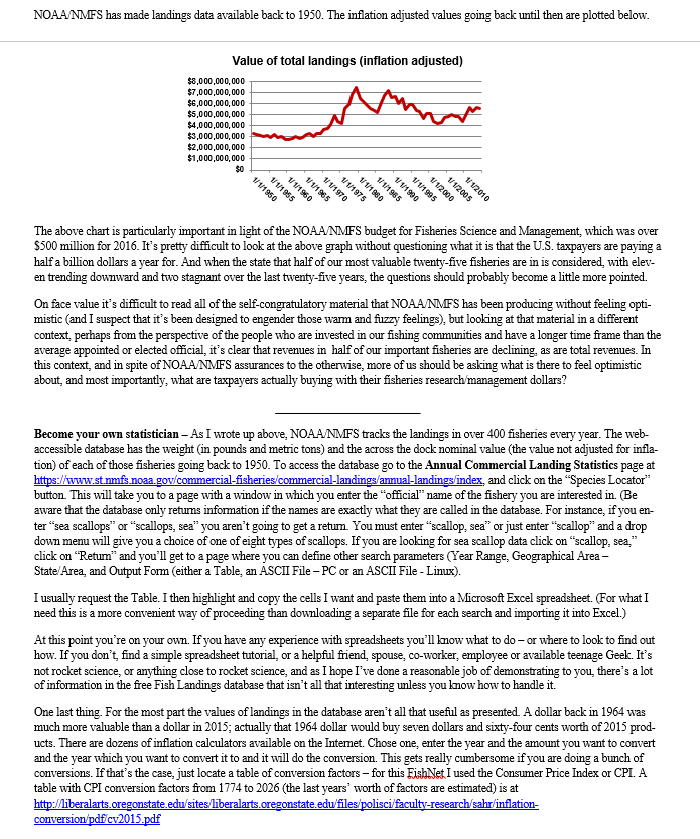



























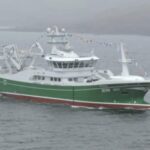
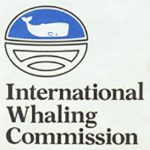
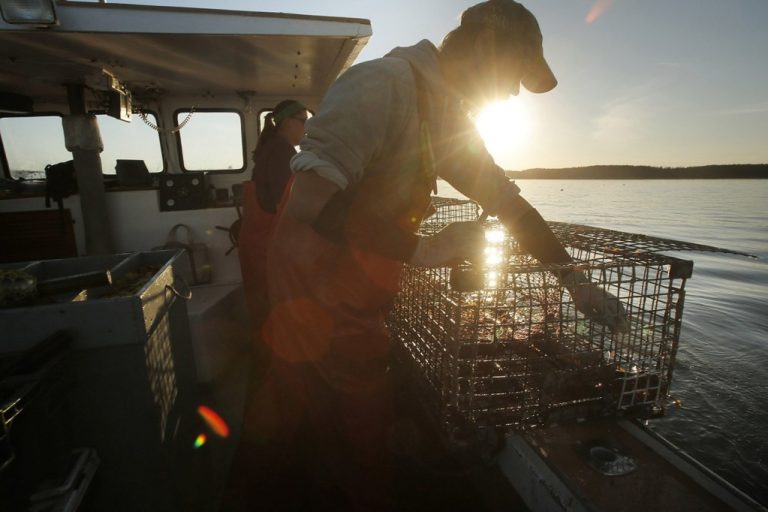
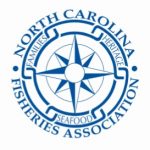
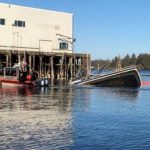
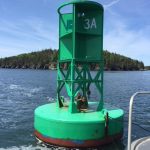

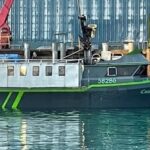
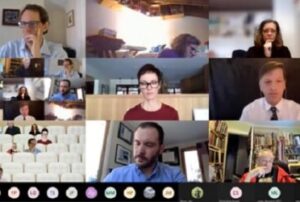
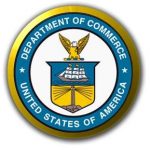
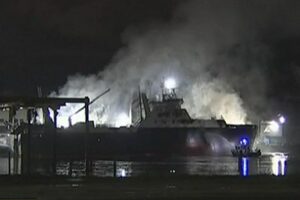
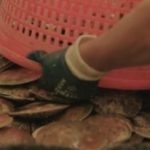



A note from Nils Stolpe: Comment on Proposed Hudson Canyon National Marine Sanctuary
I suspect, particularly considering the new and newly active Supreme Court, that there is going to be a huge push to fulfill the aspirations of the various “anti” groups to implement (impose?) their wish lists ASAP. I suspect as well that the current administration is worried about the appearance of its carte blanche granting of seemingly “do anything you want in the oceans” policy vis a vis wind power and is throwing this out as an indication that it really does care about the oceans. The effectiveness of so-called Marine Sanctuaries is still questionable but that’s no guarantee that you won’t have one in your bit of the ocean if the idea proliferates. Please take the time to go to Notice of Intent to Conduct Scoping and to Prepare a Draft Environmental Impact Statement for the Proposed Hudson Canyon National Marine Sanctuary and comment on this issue. Please keep in mind the fact that your waters and your fishery might be next. Nils 13:24
Share this post